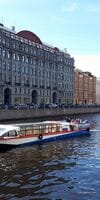The Moika is a river in the center of St. Petersburg that stretches from the Fontanka River to the Bolshaya Neva in the Central and Admiralteysky districts of the city.
The length of the Moika River is 4.67 kilometers, the width reaches 40 meters, and the greatest depth is 3.2 meters.
During the history and development of the city of St. Petersburg, the Moika, from a shallow and winding stagnant river with the name "Mya", flowing from a swamp that was located near the current Field of Mars, turned into one of the beautiful waterways of the northern capital of Russia, which has great historical and cultural value for the city and the country.
The construction of stone embankments on the Moika began in 1797. Currently, the Moika River is dressed mainly in high granite walls of the embankment, which are composed of a bedded rubble slab on lime mortar and lined with massive granite stones bonded together with iron pirons.
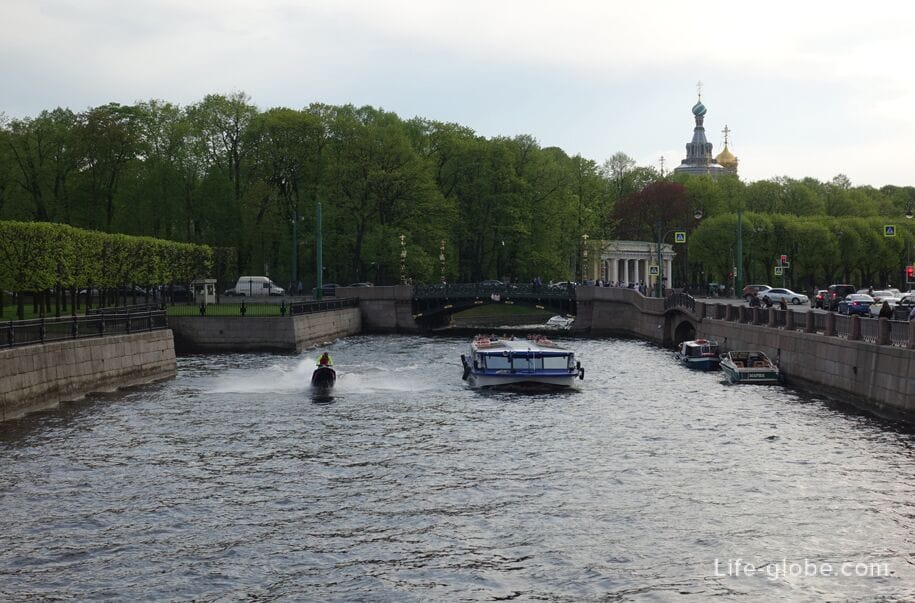

The Moika River is crossed by 15 bridges, some of which are completely pedestrian.
Bridges connect the two banks of the river - this is the embankment of the Moika River, which is mainly carriageway and pedestrian.
Along the embankment, mostly in dense rows, there are historical buildings - former palaces, mansions and apartment buildings, which creates a beautiful panorama of the river.
Among the significant objects along the Moika embankment are: Mikhailovsky (Engineering) Castle, Summer and Mikhailovsky Gardens, Field of Mars, New Holland Island, Yusupov Palace, Mariinsky Palace, Razumovsky Palace, Stroganov Palace, Eliseevs' house-palace, Alexey Alexandrovich's Palace, The State Academic Chapel named after M. Glinka, the Central Naval Museum named after Peter the Great, the mansion where the last months of Pushkin's life were spent and where the Pushkin Memorial Museum apartment is now located; as well as the historical department store "At the Red Bridge" and the historical bath complex "Lantern Baths".
There are cafes and restaurants, shops and salons, as well as accommodation facilities (hotels, apartments) in historical buildings on the Moika today
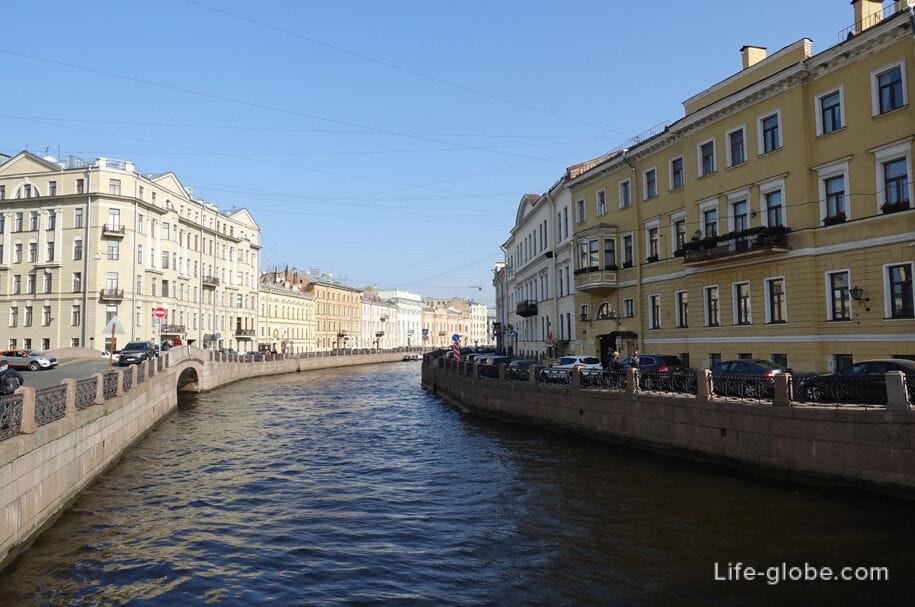
Pleasure boats run along the river, the berths of which are located along the river, including: "Moika Embankment. Yusupov Palace" (city pier) and "Moika Embankment, 44".

Bridges and sights of Moika (walk along the river)
The Washing begins from the 1st Engineering Bridge, thrown over the river at the place where it flows out of the Fontanka River.
The bridge is a single-span metal prestressed frame structure with a curvilinearly outlined crossbar and a reinforced concrete slab of the roadway.
The bridge is both carriageway and pedestrian. Learn more about the 1st Engineering Bridge...
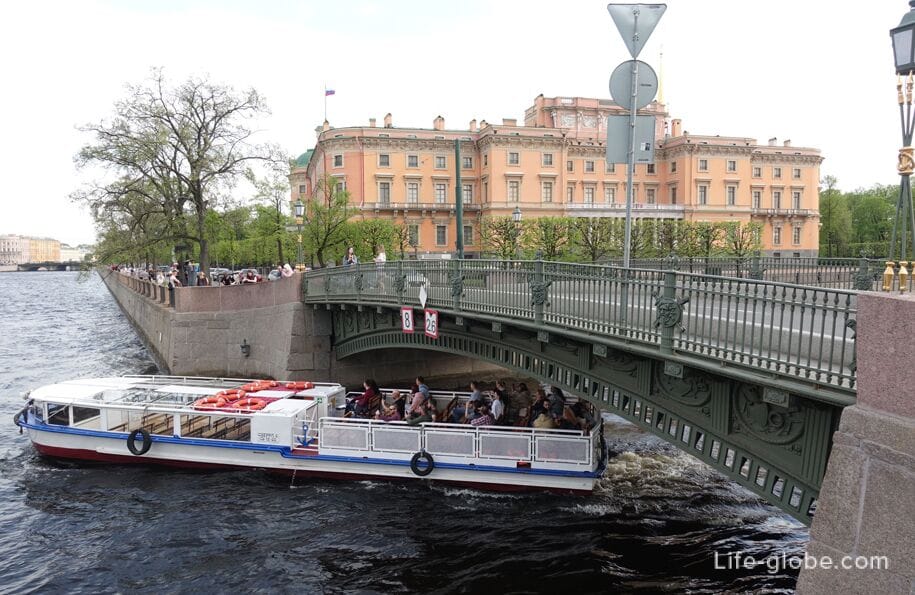
Near the 1st Engineering Bridge, on the side of the Fontanka River, there is one of the iconic sights of St. Petersburg - a small bronze sculpture "Chizhik-Pyzhik".
An interesting story about students is connected with the sculpture. Also, they say, the Chizhik-Pyzhik fulfills wishes. Learn more about the Chizhik-Pyzhik, its history and signs ...
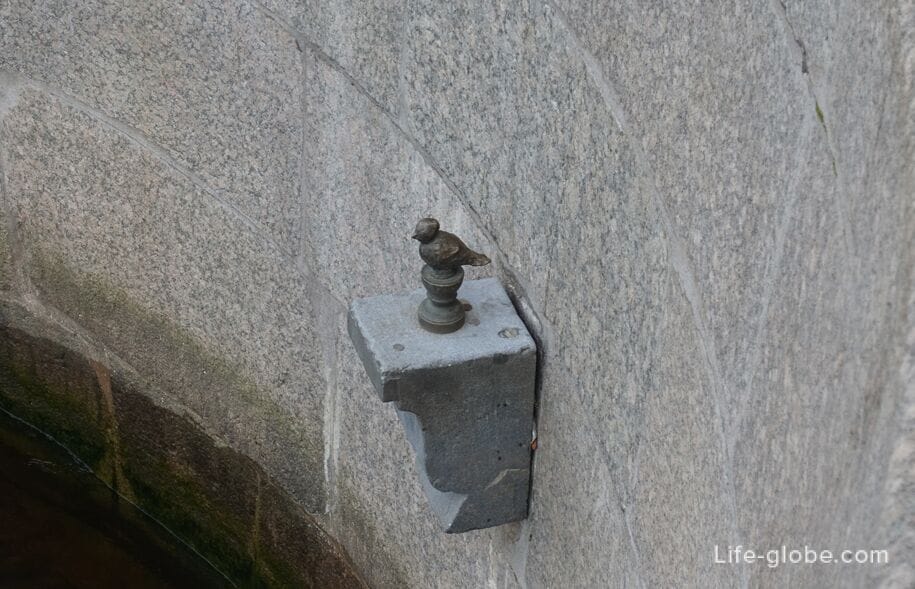
Further, on the left side of the Moika River (south) is located Mikhailovsky (Engineering) Castle, a former imperial palace, is the largest architectural monument in the style of romantic classicism, completing the history of St. Petersburg architecture of the 18th century.
Today Mikhailovsky Castle is part of an architectural complex The State Russian Museum. Part of the museum's collections are exhibited within its walls and temporary (rotating) exhibitions are held. More about Mikhailovsky Castle...

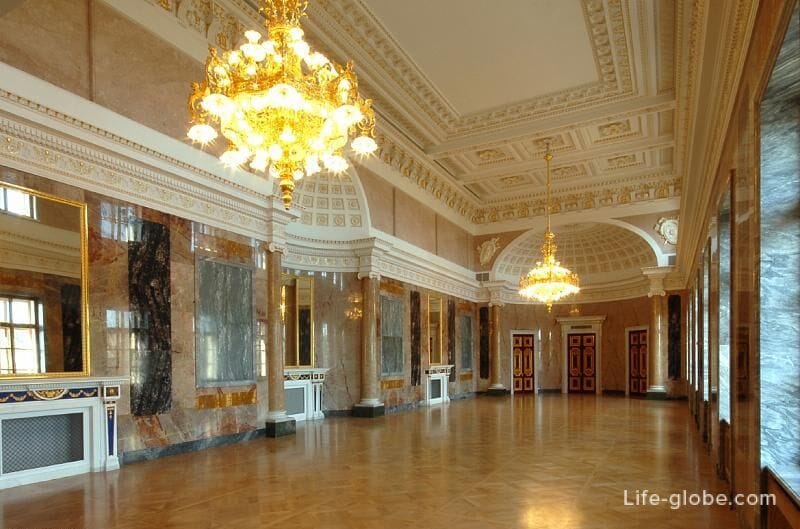
On the right (northern) side of the Sink is spread out The summer garden, which is located on the island of the same name and is the most beautiful park in the center of St. Petersburg.
In the park: Peter I Summer Palace (now a museum), other buildings (pavilions), alleys and paths for walking, cafes, places to relax, a pond, a parterre, bosquets, borso, fountains, sculptures, monuments and an exposition of the history of the Summer Garden. More about the Summer Garden...
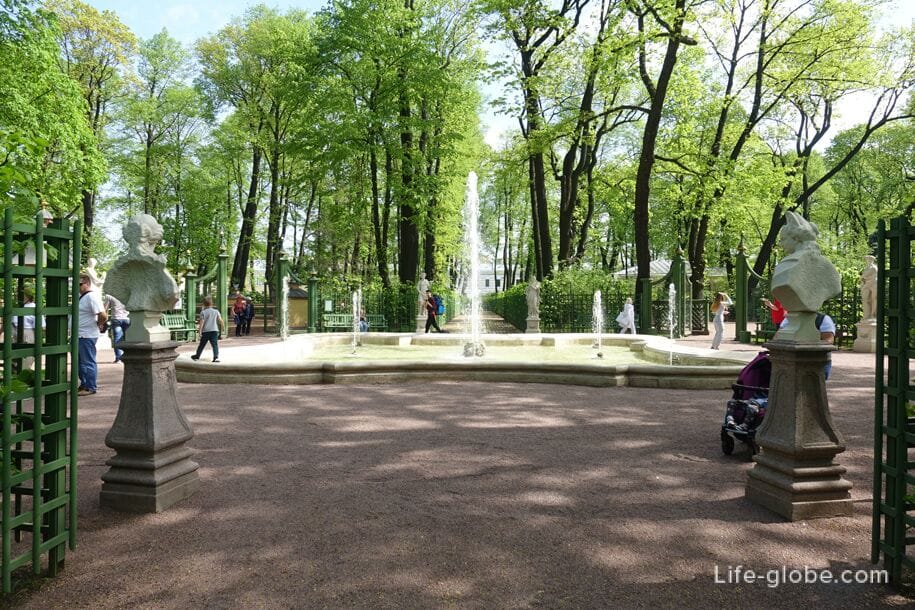
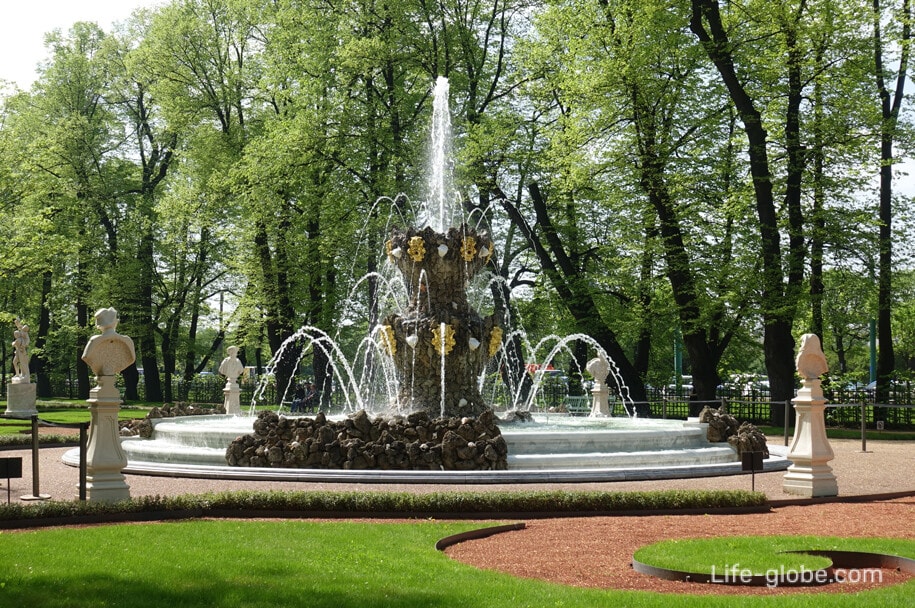
Beyond the Summer Garden flows the Swan Groove, connecting the Neva River with the Moika River.
At the Moika River, the Lower Swan Bridge, which is a single-span arch bridge, is thrown over the Swan Groove. Learn more about the Swan Groove...
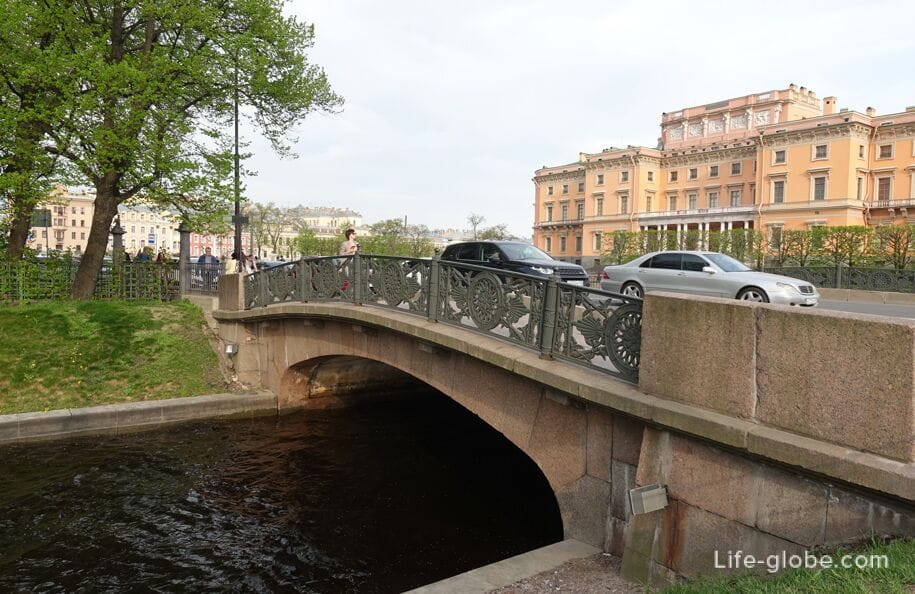
Near the Swan Groove, the 1st Garden Bridge is thrown across the Sink along the axis of Sadovaya Street, which is a single-span arch structure, the span of which is a steel double-hinged arch with a through arch structure.
The bridge is a roadway and a transitional one. Learn more about the 1st Garden Bridge...
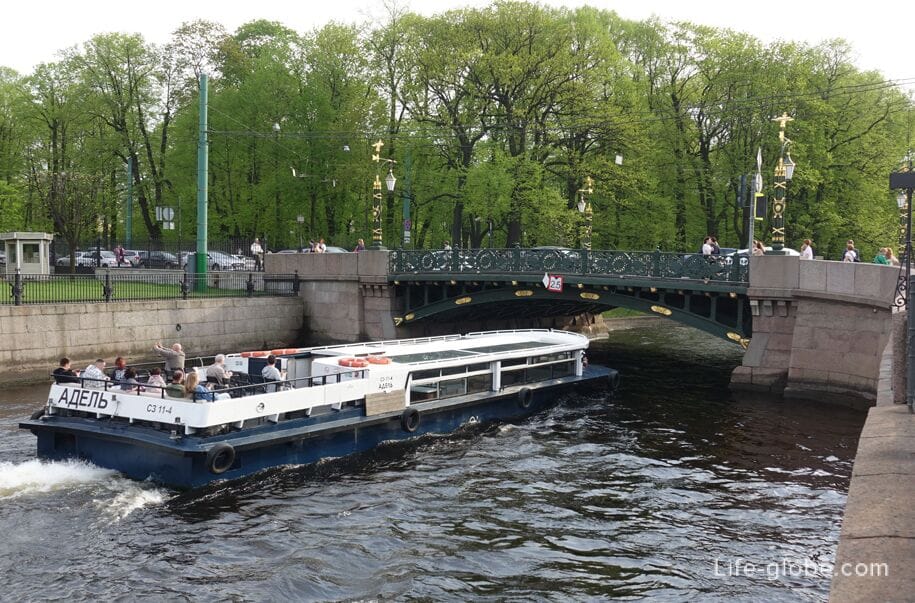
Behind the 1st Garden Bridge on the south side of the Sink is located Mikhailovsky Garden, which is one of the rarest monuments of landscape architecture of the 18th - first third of the 19th centuries and is a public park with a unique combination of two different styles of landscape art: regular ("French") and landscape ("English").
In the garden, near the bank of the Moika River, there is the Rossi Pavilion with a granite pier, built in the classical style in 1823-1825 and served as a place of rest during walks and shelter from the weather. Learn more about the Mikhailovsky Garden and the pavilion...
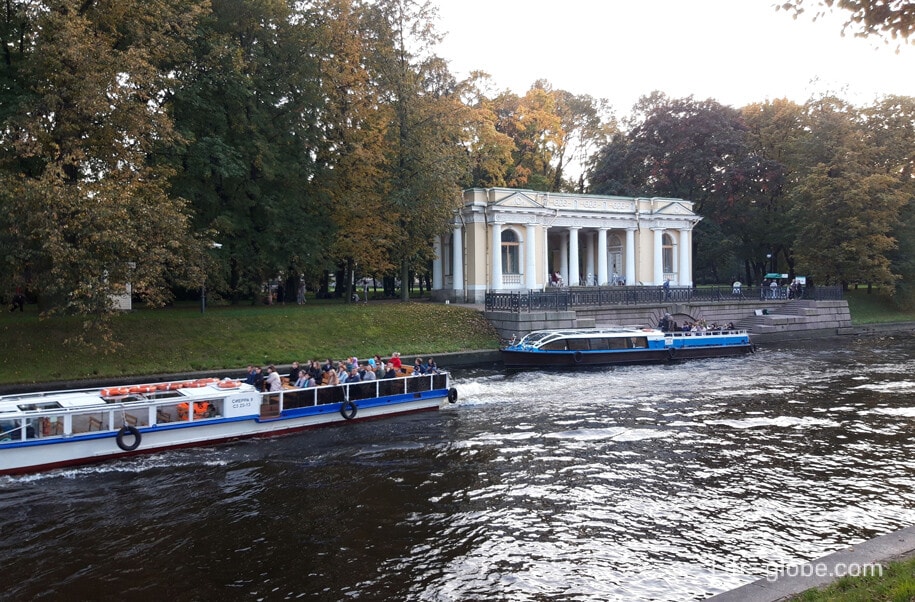
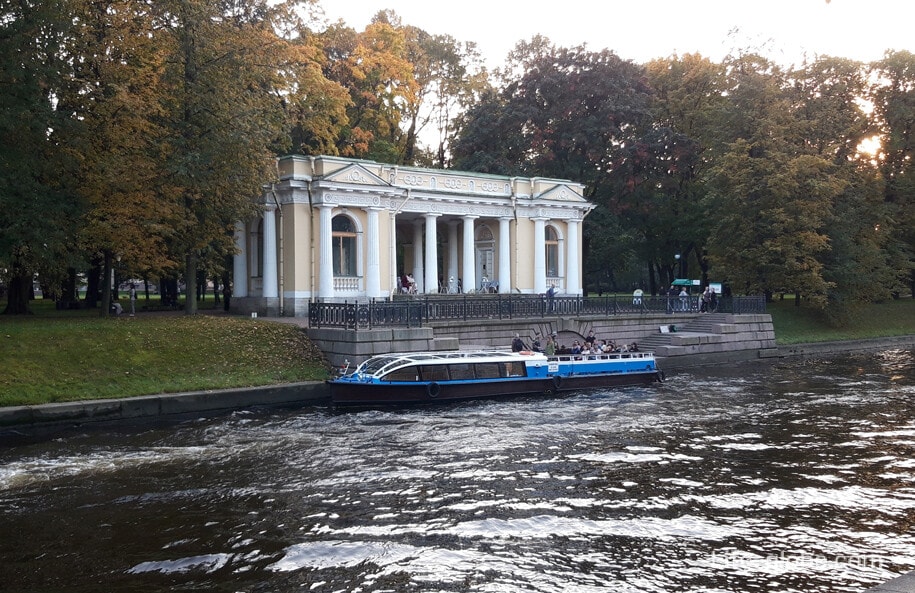
In the Mikhailovsky Garden there isMikhailovsky Palace, once a grand ducal palace and built by order of Emperor Alexander I for Grand Duke Mikhail Pavlovich. More about the Mikhailovsky Palace...
Today, the State Russian Museum is located within the walls of the building. More about the Russian Museum...
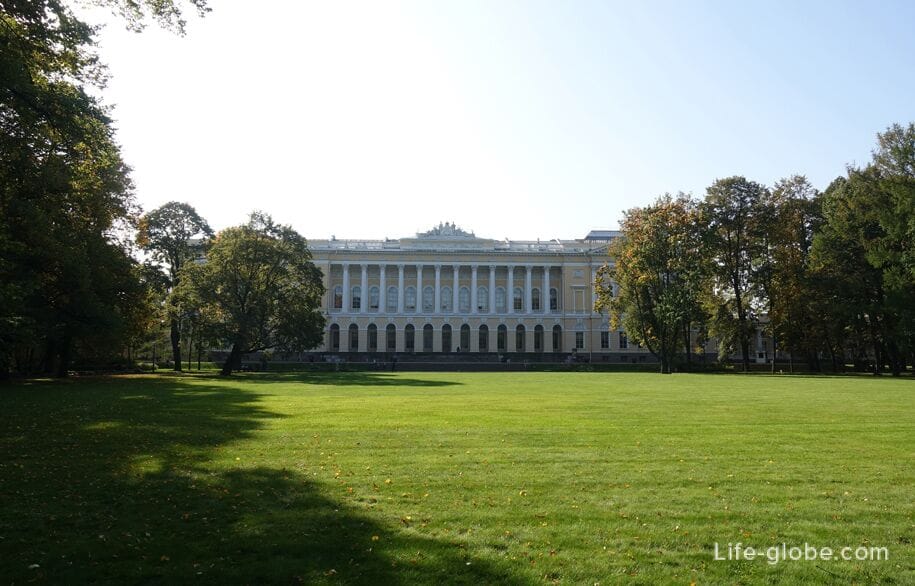

On the north side of the Sink from the Alexander Garden stretchesThe Field of Mars, which is a green zone and a square in the center of which there is a Monument to the fighters of the Revolution (Eternal Flame).

Behind the Field of Mars and the Mikhailovsky Garden, the 2nd Garden Bridge is thrown across the Moika, which is a single-span reinforced concrete structure, the span of which is made in the form of a three-hinged frame, with a curved outline of the lower belt from the facades.
The bridge is both carriageway and pedestrian. Learn more about the 2nd Garden Bridge...
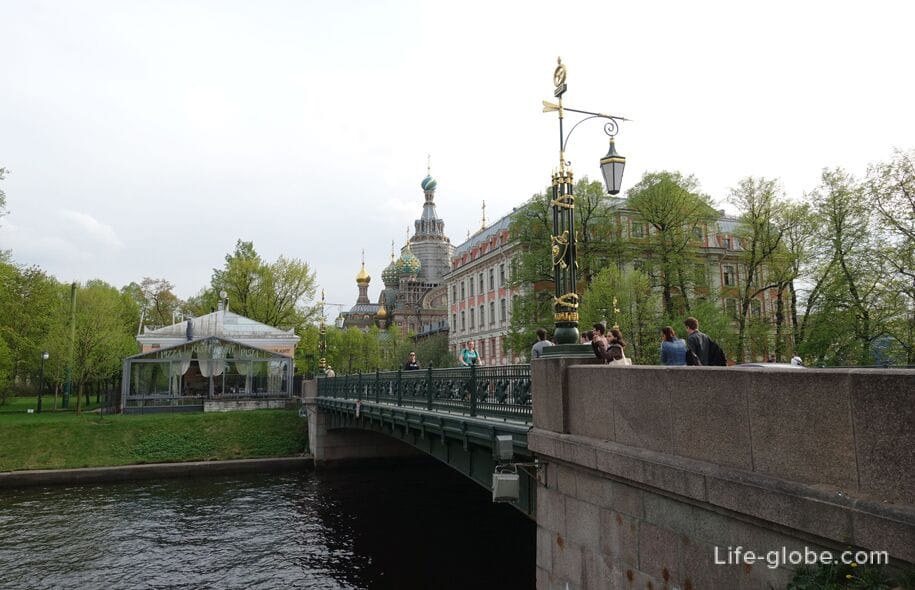
Then it will be thrown over the sink Malo-Konyushenny bridge, which is a unique Tremonte Petersburg (Triple bridge) is the unofficial name of the bridge's composition in St. Petersburg, which includes two bridges: the bridge Theatre and Malo-Konyushenny bridge, as well as About the bridge (or falsity of the bridge), which is not a bridge in the truest sense of the word and is of the Pedestrian (Land bridge)-the dam. Learn more about the Three-Bridge...

Next to the Trehm Bridge, on the Embankment of the Moika River, there is a historic building - the Adamini House, which was erected in 1823-1827 for merchant Antonov, designed by the Russian architect and engineer of Swiss origin Domenico Adamini.
By the name of merchant Antonov, the building is sometimes called the Antonov house, and the generally recognized name is the Adamini House, which the building received on behalf of its architect.
Address of Adamini's house: Moika embankment, 1 / Aptekarsky lane, 8 / Field of Mars, 7.
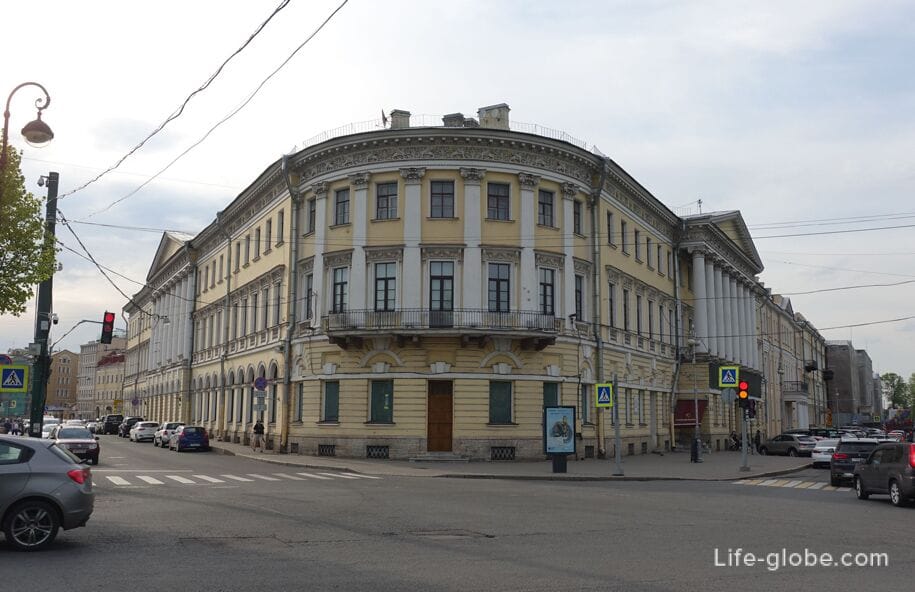
Behind the Adamini building along the embankment of the Moika River 3, the historical structure of the Round Market in the classical style is noteworthy, which is one of the oldest markets in the city and an architectural monument of the 18th century, erected according to the project of Giacomo Quarenghi in 1785-1790.
The stone building of the market is triangular in plan, but with rounded edges.
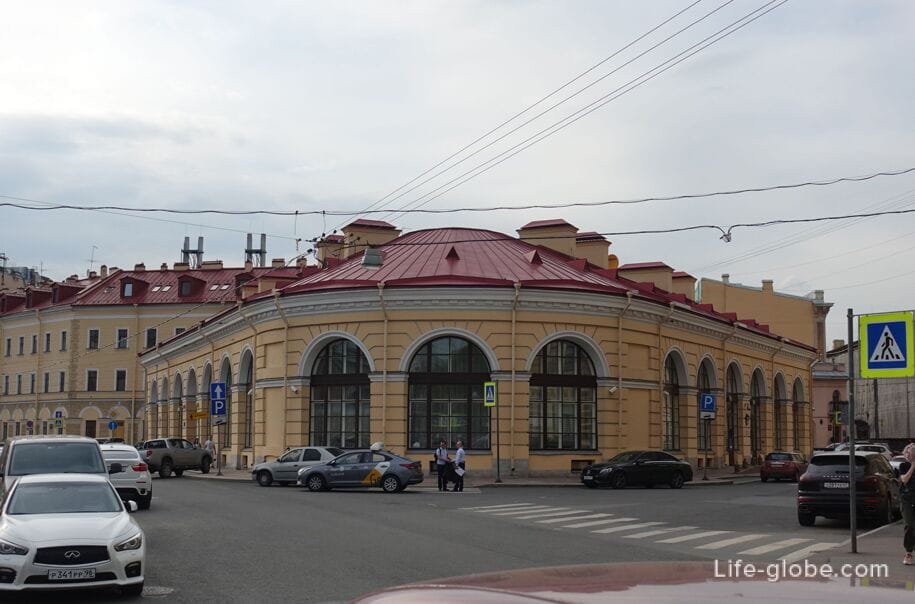
On the opposite side of the Sink, from the Round Market, there are former The Main Imperial Stables (Stable Department) is a historical architectural ensemble built in 1720-1723 by architect Nikolai Gerbel by decree of Emperor Peter I. In 1817-1823, the ensemble was reconstructed by Vasily Stasov.
The complex included the church of the Stable Department (the Church of the Saviour of the Uncreated Image at the Court-Stable part).
View of the river and embankments
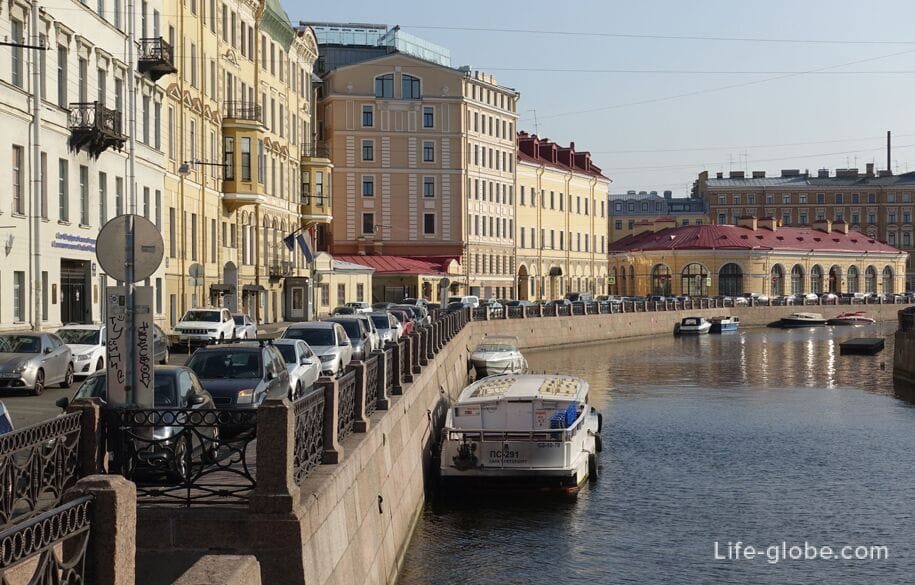
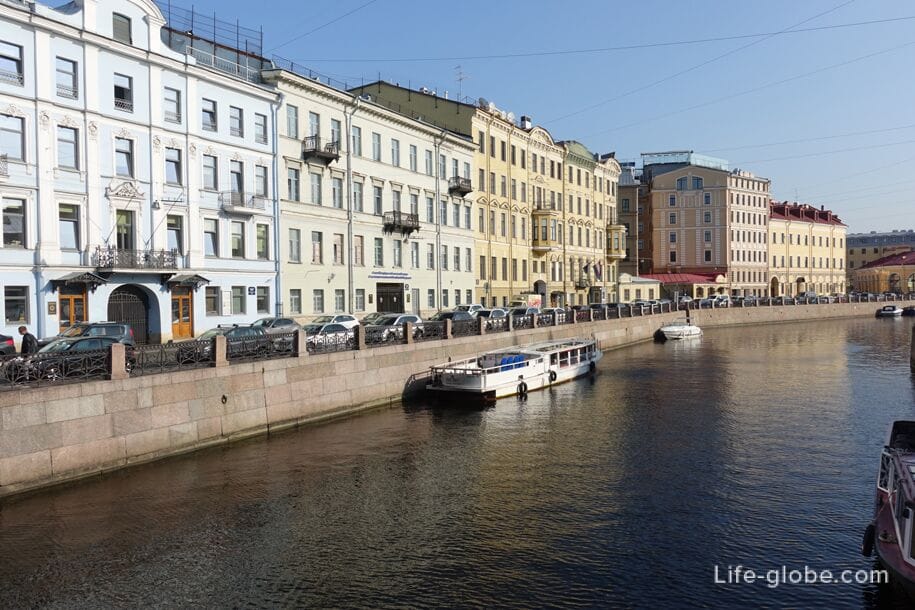
Downstream of the river, across the Moika River, there is a Bolshoi Konyushenny Bridge, which is a single-span arched metal structure with a hinged vault.
The bridge is both carriageway and pedestrian. Learn more about the Bolshoy Konyushenny Bridge...
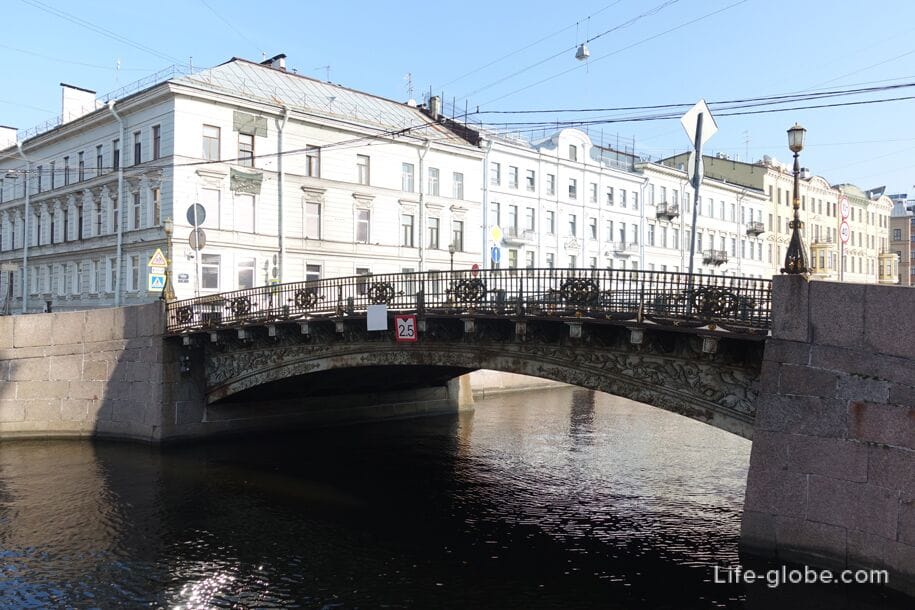
Further along the Moika River embankment are notable:
- house No. 21, the house of Prince Semyon Semyonovich Abamelek-Lazarev, made in the style of classicism;
- house No. 23, also the house of Prince Semyon Semyonovich Abamelek-Lazarev, but made in the neoclassical style. The building was built in 1913-1914 by the outstanding architect Ivan Aleksandrovich Fomin and today is one of the pearls of St. Petersburg architecture: a strict ceremonial parapet above the entablature, elegant white pilasters of the Corinthian order;
- house No. 12, the former mansion of the Princes Volkonsky, which now houses the memorial museum-apartment of A.S. Pushkin;
- house No. 14, a mansion in the eclectic style, in which Ivan Ivanovich Pushchin lived.
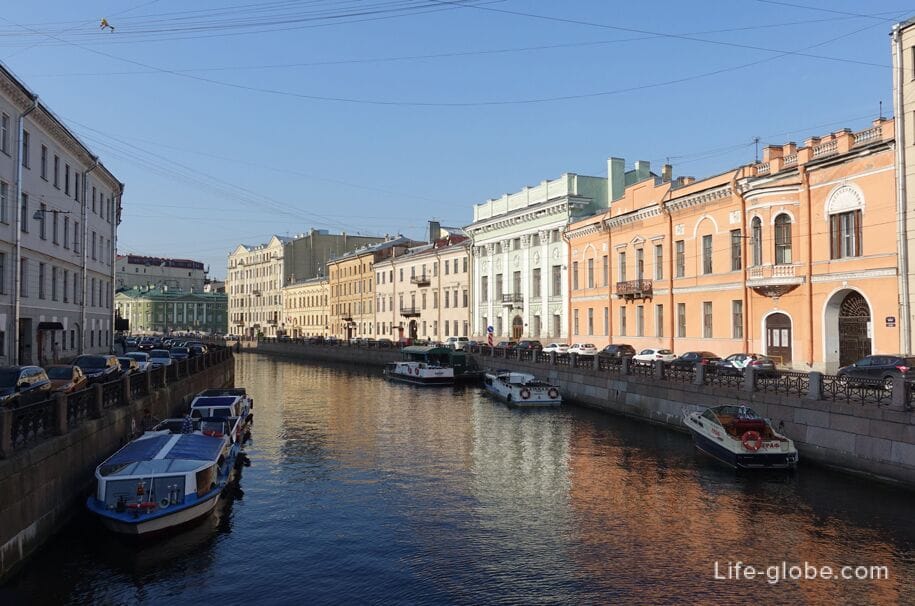
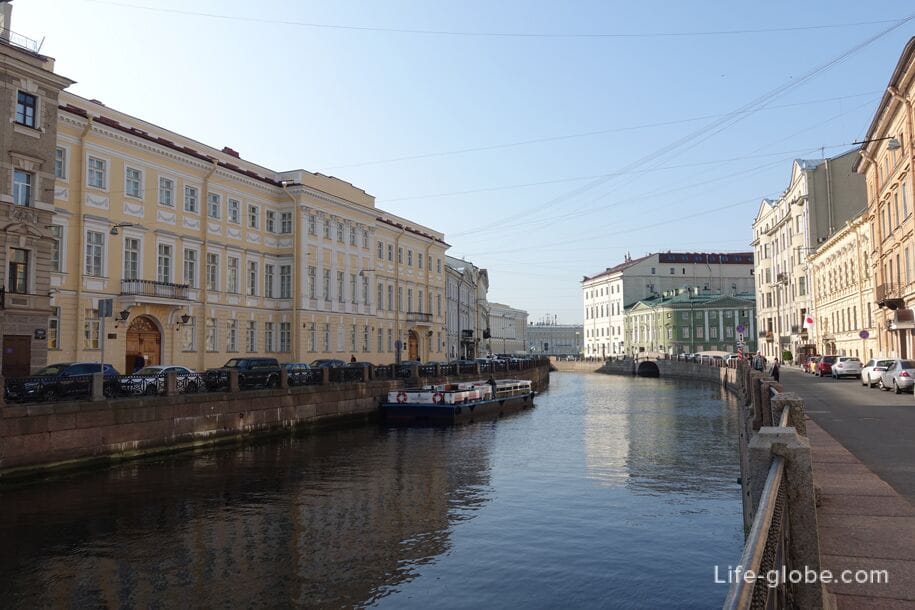
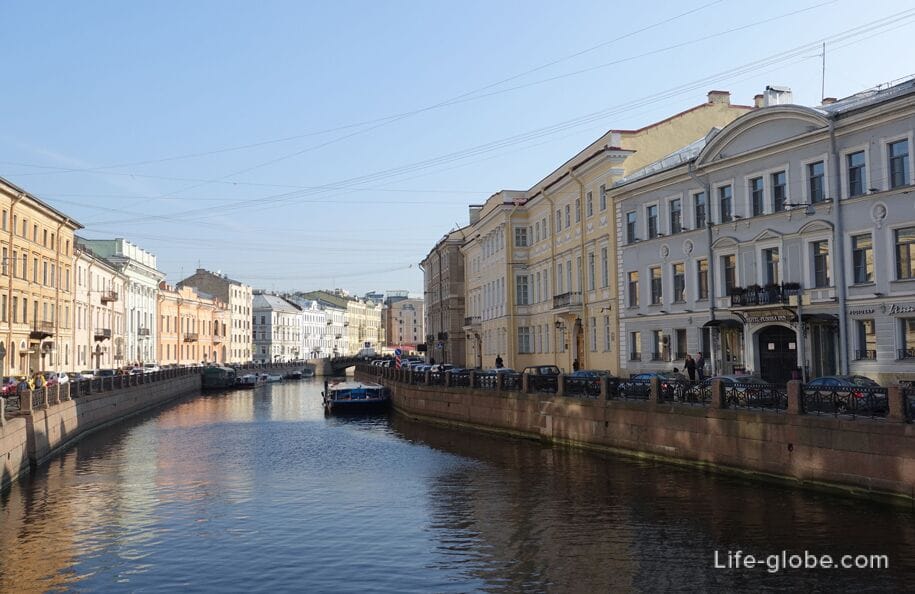
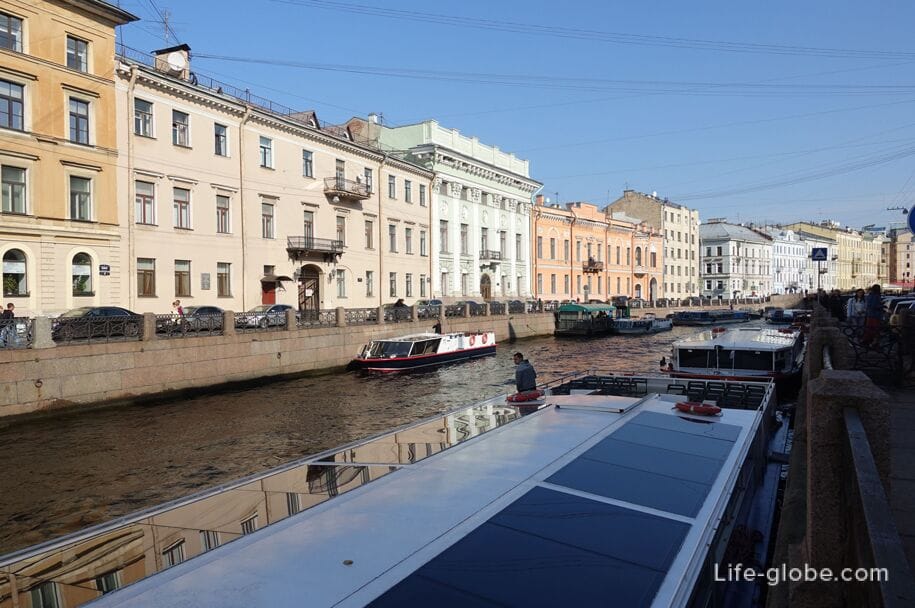
Then the Moika River and the Neva River are connected by one of the oldest canals of the city - the Winter Groove, which is one of the most attractive places in the center of St. Petersburg.
In the alignment of the Moika River embankment, the 2nd Winter Bridge is thrown over the Winter Groove, which is a single-span reinforced concrete arched structure, the span of which is made in the form of a hinged arch.
Near the 2nd Winter Bridge and the Moika Embankment (No. 35) there is a memorable and miniature house of A.A. Arakcheev, made in the style of classicism.
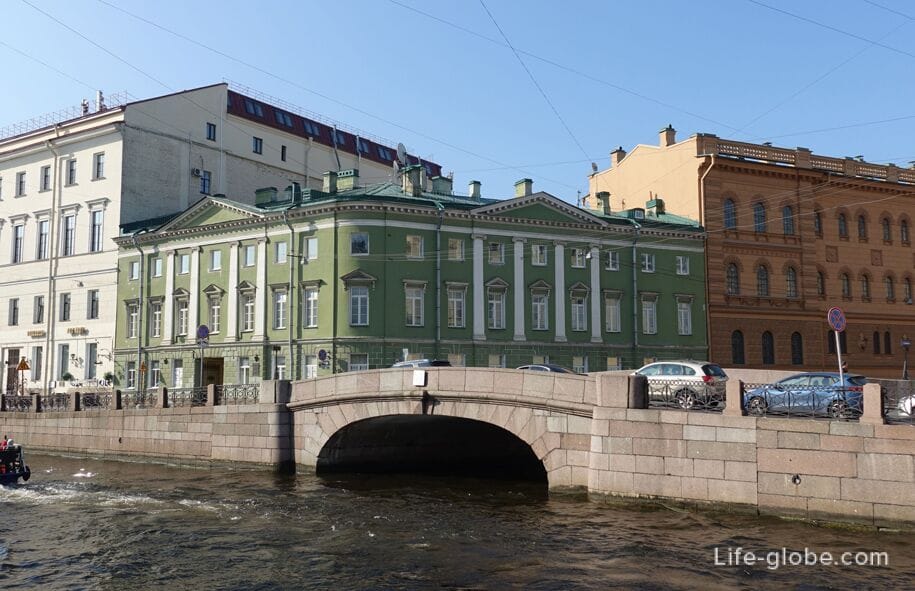
On the opposite side of the 2nd Winter of the bridge (from home Arakcheev), on the embankment of the Moika river is located 31-32 corner building - the apartment house of Fersen style Neoclassicism, which is more popularly known as the home of Sobchak (boyar), since in one of the apartments of the house, the first and only mayor of St. Petersburg has lived for many years in the 2000-th year. More about the Winter Groove...
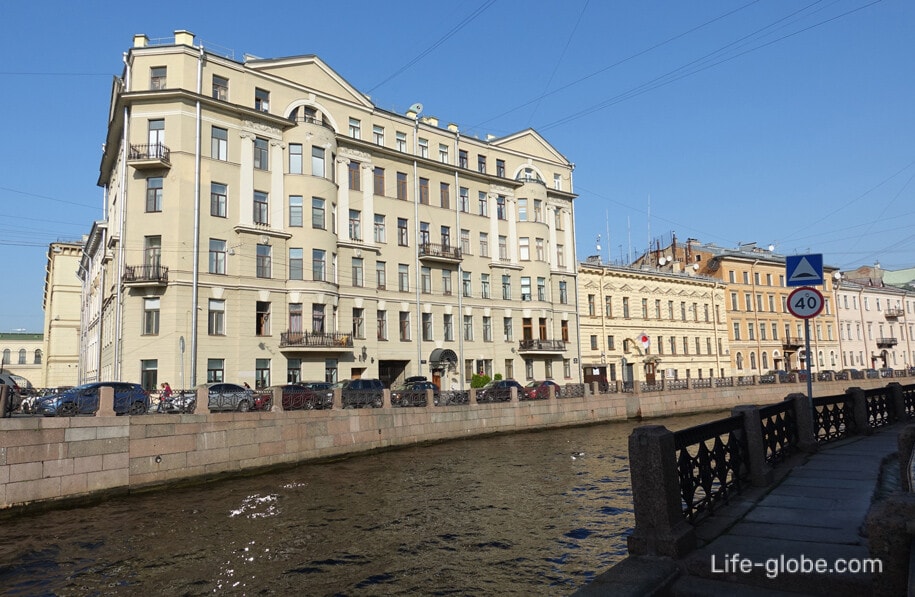
Downstream of the Moika River is locatedThe Singing Bridge, which is one of the widest in St. Petersburg and one of the main ones, since it leads to the central square of the city - Palace Square with the Winter Palace (now The Hermitage) and Alexander column.
The bridge is both carriageway and pedestrian. It is a metal single-span arched structure, on the foundations of rubble masonry with granite cladding. A reinforced concrete superstructure is installed on top of the cast-iron structure to strengthen the bridge. More about the Singing Bridge...

On one side of the Singing Bridge there is a Chapel gate leading to a complex of buildings and courtyards The State Academic Chapel, from which the bridge received the name "Singing"; and on the other - the historical building of the General Staff.
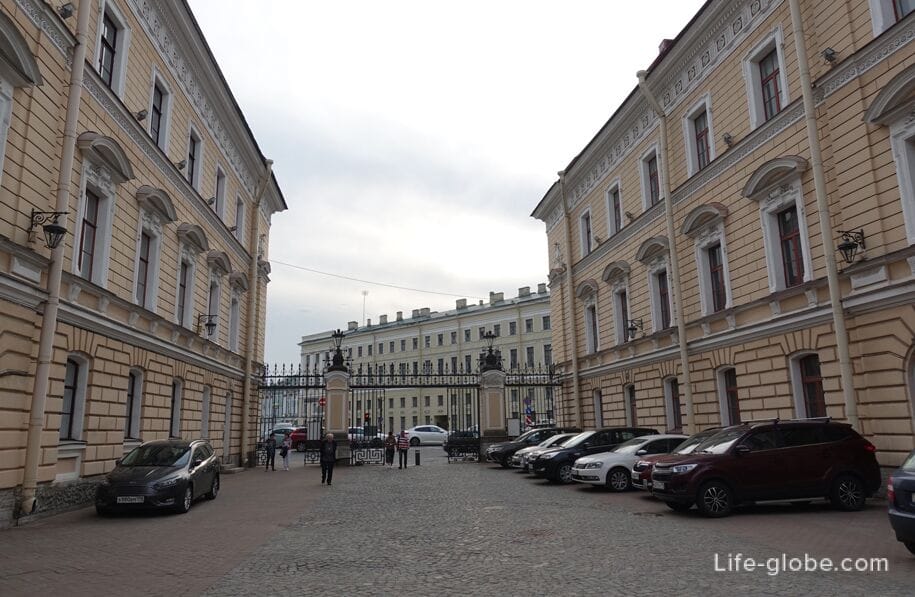

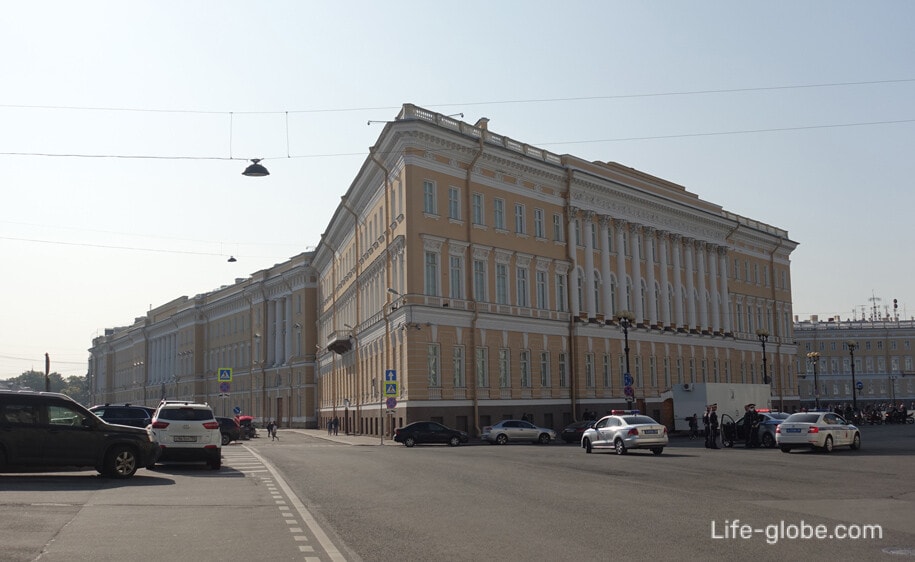
At the address: Moika River Embankment 22, in the walls of an old aristocratic mansion built in 1853 is 5-star Kempinski Moika 22 Hotel with panoramic restaurant with city views, tea room and wine cellar, bar, free Wi-Fi, spa, fitness center and facilities for disabled guests.
The rooms are equipped with a flat-screen TV, air conditioning, a minibar, a safe, bathrobes, a private bathroom with underfloor heating, a hairdryer and free toiletries. Each room has a coffee machine or an electric kettle.
A buffet breakfast can be included in the room rate. Link to the hotel
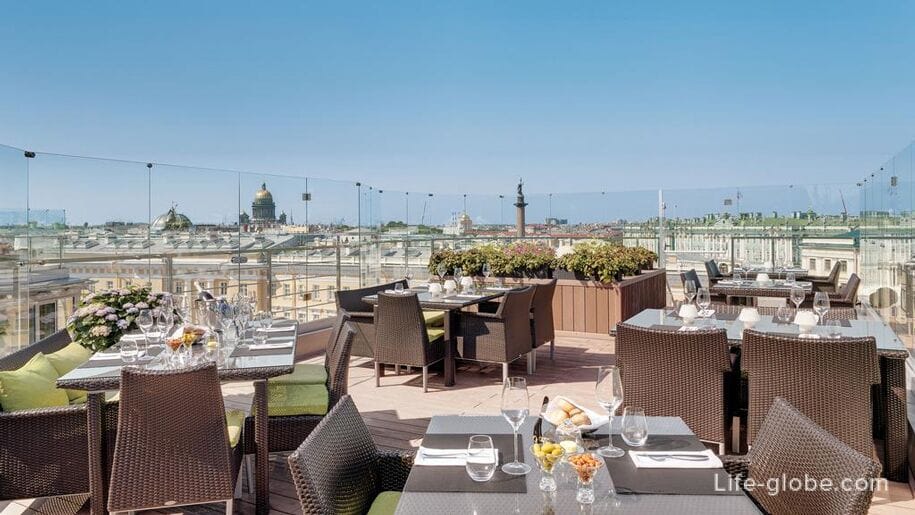

There is a Green Bridge downstream of the river, which is thrown over the Sink along the axis Nevsky Prospekt.
The bridge is a single-span metal structure of an arched structure.
On the bridge, on granite bollards, four (two on each side) metal decorative floor lamps with hexagonal lanterns are installed.
The bridge is both carriageway and pedestrian. Learn more about the Green Bridge...
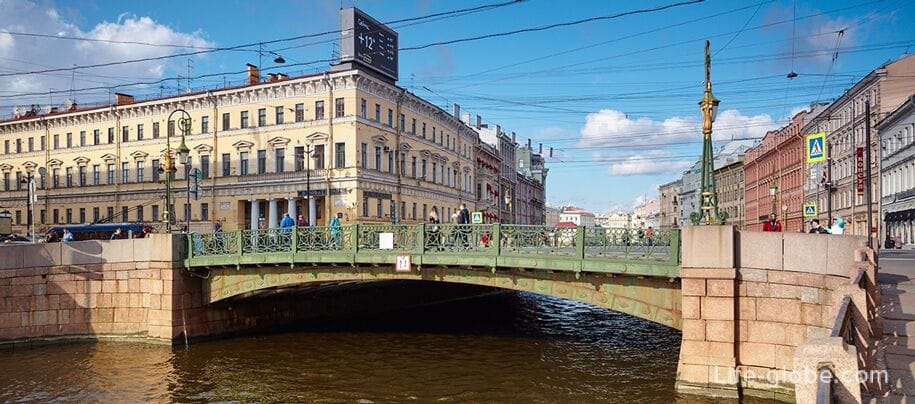
Near the Green Bridge there are such attractions as: the Eliseevs' house-Palace with the 5-star Talion Imperial Hotel hotel link to the hotel (Nevsky Prospekt, 15), Neiman's House (Nevsky Prospekt, 18), Stroganov Palace - now The Russian Museum (Nevsky Prospekt, 17) and the house of the Dutch Reformed Church (Nevsky Prospekt, 20).
Photo of the house-palace of the Eliseevs
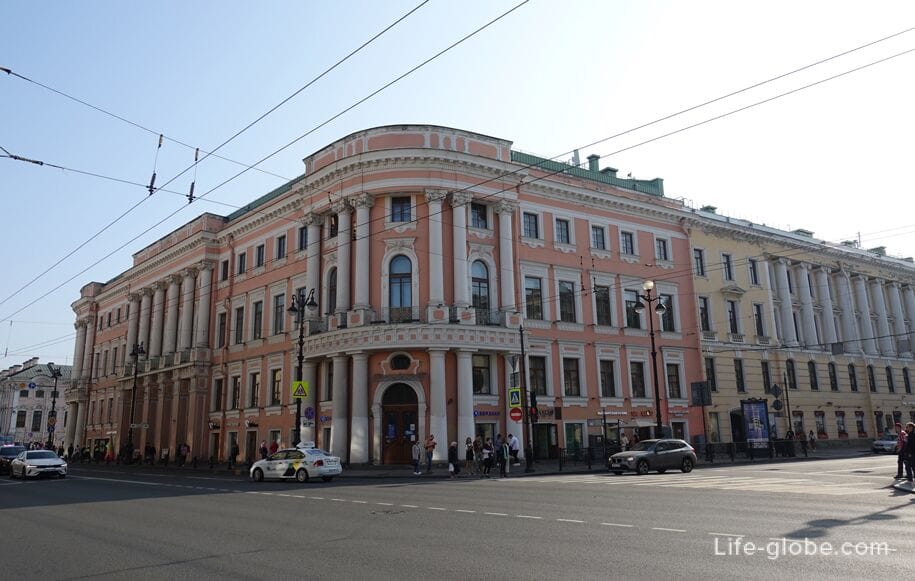
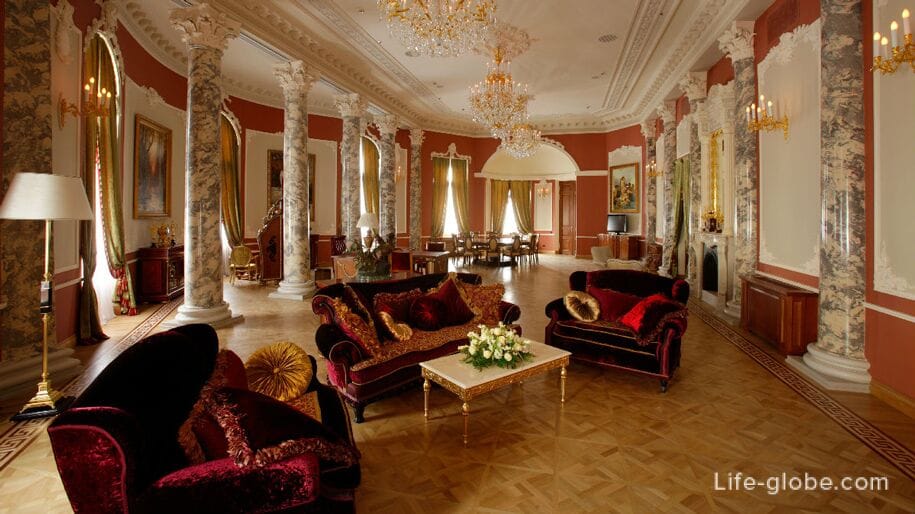
Photo of the Neumann house
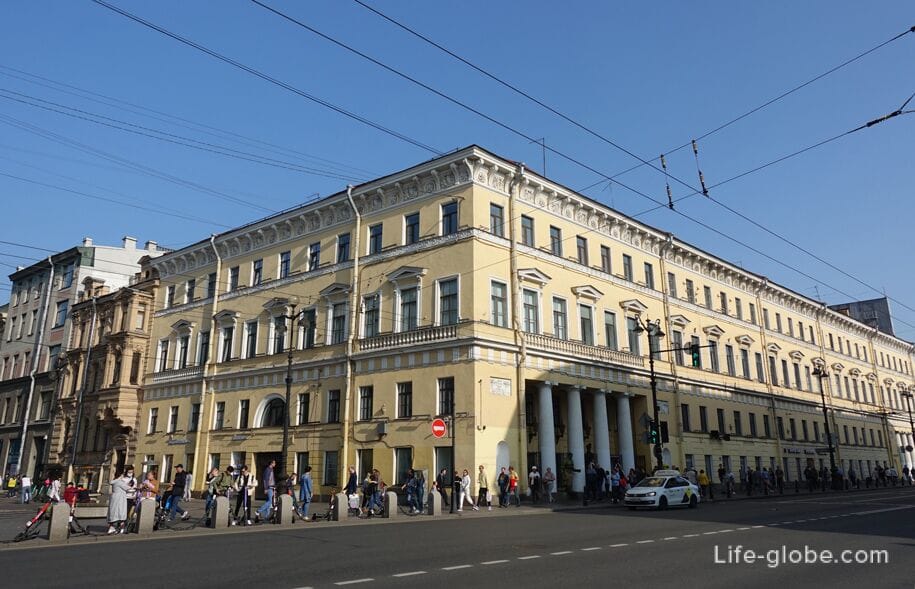
Photo of the Stroganov Palace
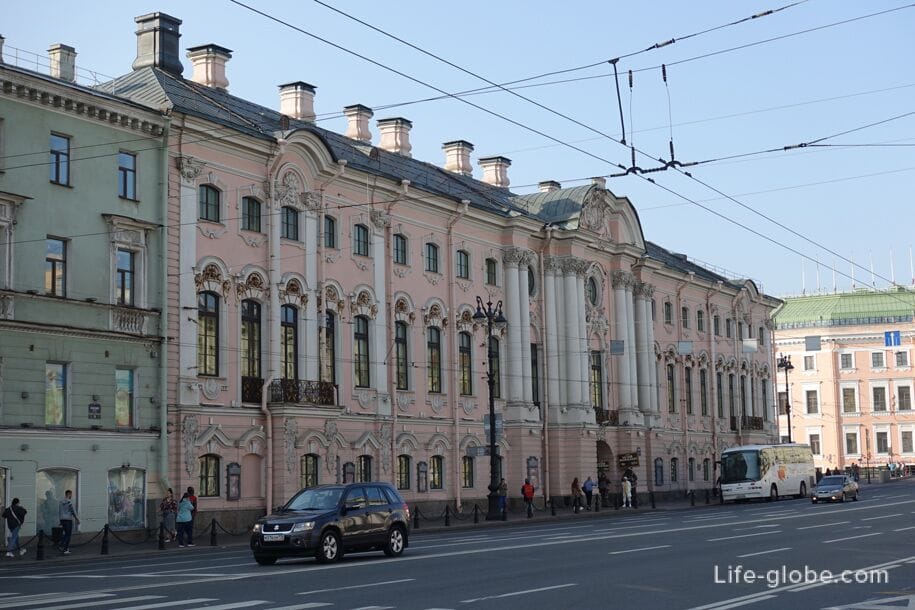
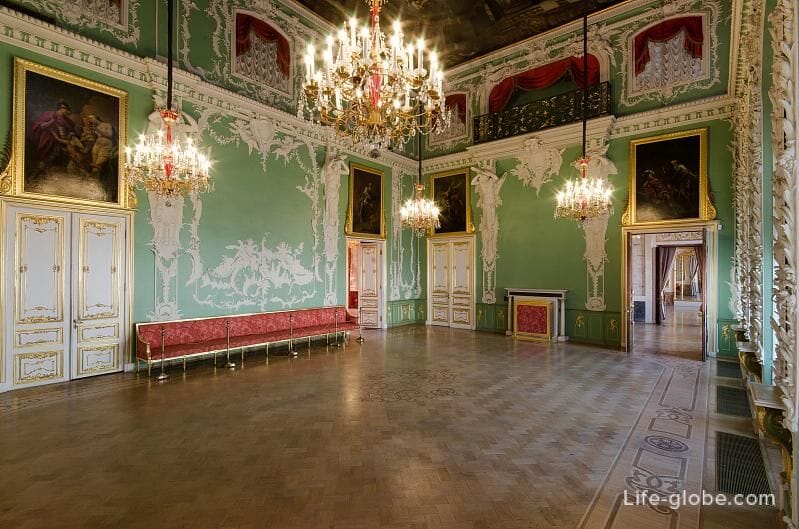
Photo of the Dutch Reformed Church
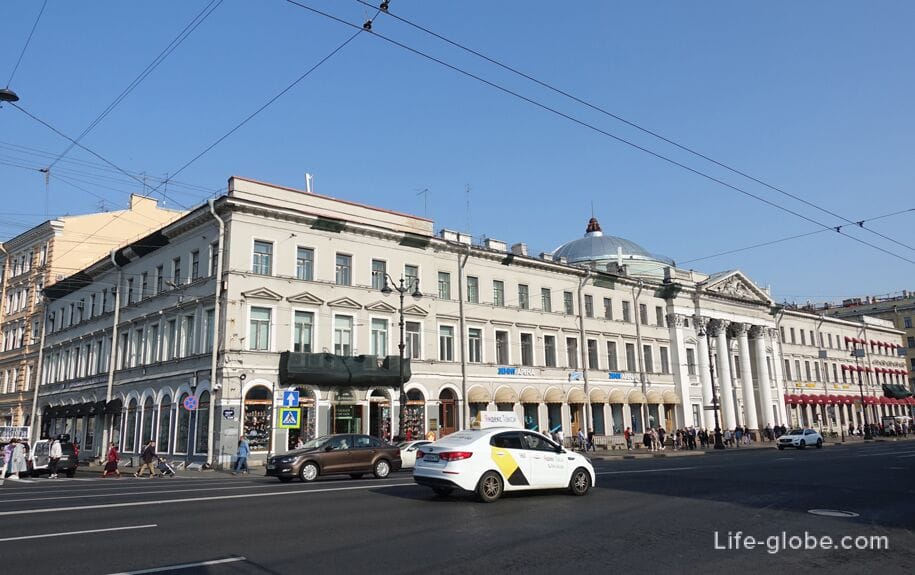
At the address: Moika River Embankment 48, the former palace of K.G. Razumovsky is located, which is one of the few examples of urban estates of the first half of the 18th century preserved in St. Petersburg with regular gardens and buildings located in the depths of the plots.
Razumovsky Palace includes several buildings, as well as an Old Garden.
Today, the complex houses the main campus of the A.I. Herzen Russian State Pedagogical University. More about the Ryzumovsky Palace...
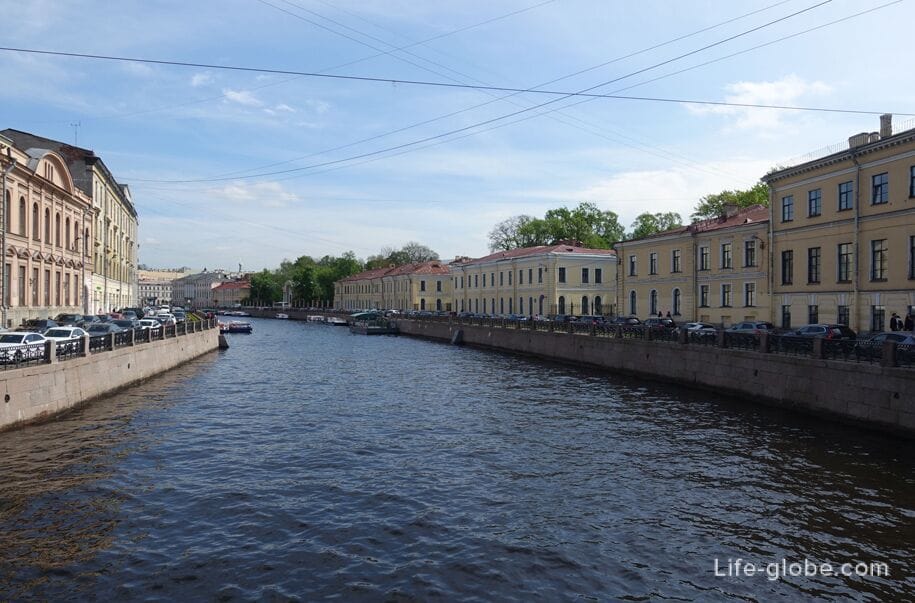
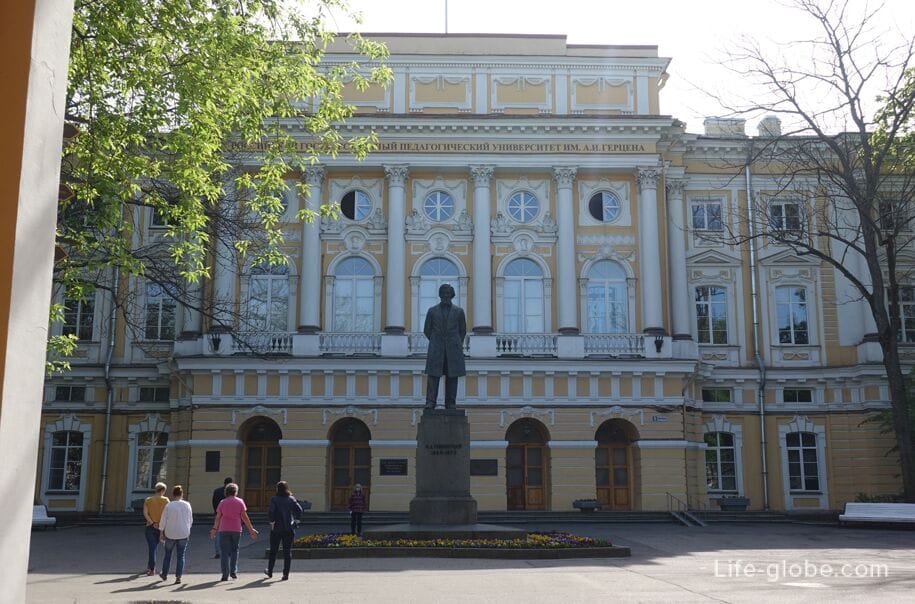
Downstream of the river through the Sink is thrown The Red Bridge, which is one of the oldest in St. Petersburg, has preserved its external historical appearance since the beginning of the 19th century.
The bridge is a single-span metal structure consisting of seven double-hinged welded arches interconnected by a system of transverse beams and longitudinal ties.
Granite cone-shaped obelisks with four-sided lanterns on metal brackets and gilded balls are installed at the entrances to the bridge.
The bridge is both carriageway and pedestrian. Learn more about the Red Bridge...
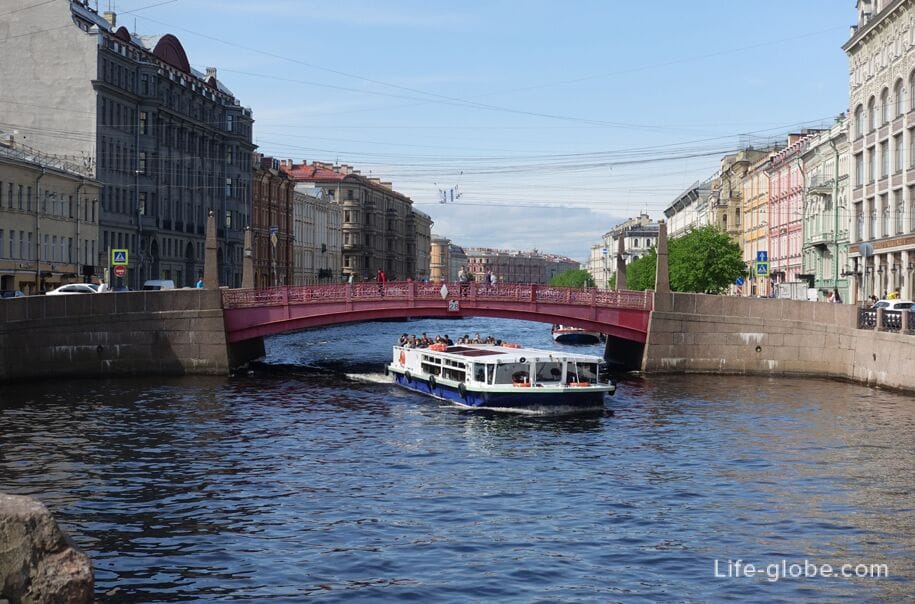
Near the Red Bridge, at the intersection of the Moika River Embankment and Gorokhovaya Street, there is a five-story building with an attic, made in the Art Nouveau style and decorated with a dome-tower with a spire.
This is a historical Trading house "S. Esders and K. Scheifals", which was the first multi-storey store in Russia (built in 1906-1907), which was popular among wealthy residents and visitors of the city, as well as with the Romanov family.
Today it is a shopping complex - department store "At the Red Bridge" (Au Pont Rouge). More about the department store "At the red bridge"...
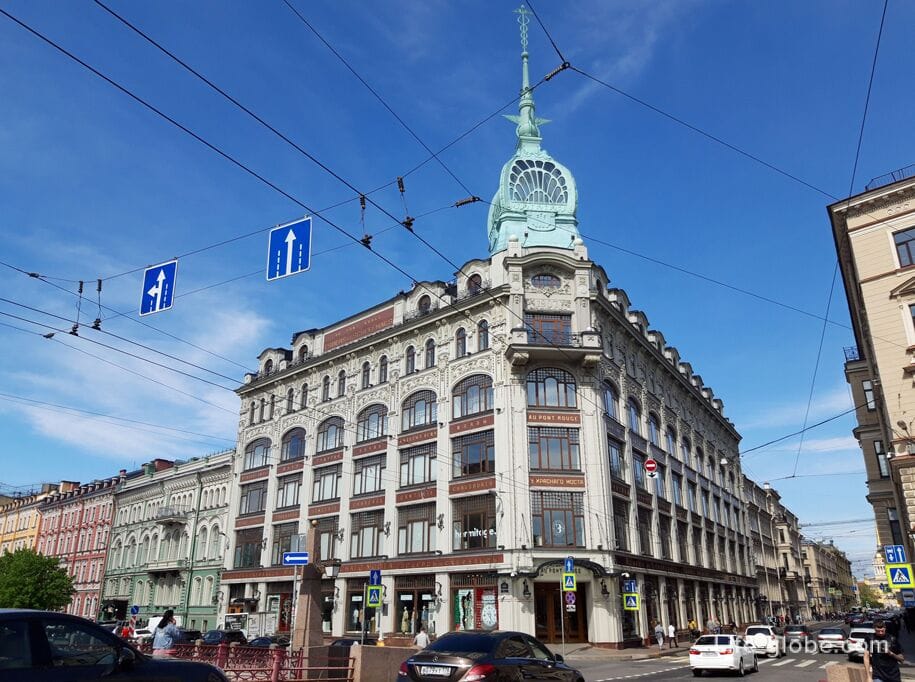

Moika River and embankments further

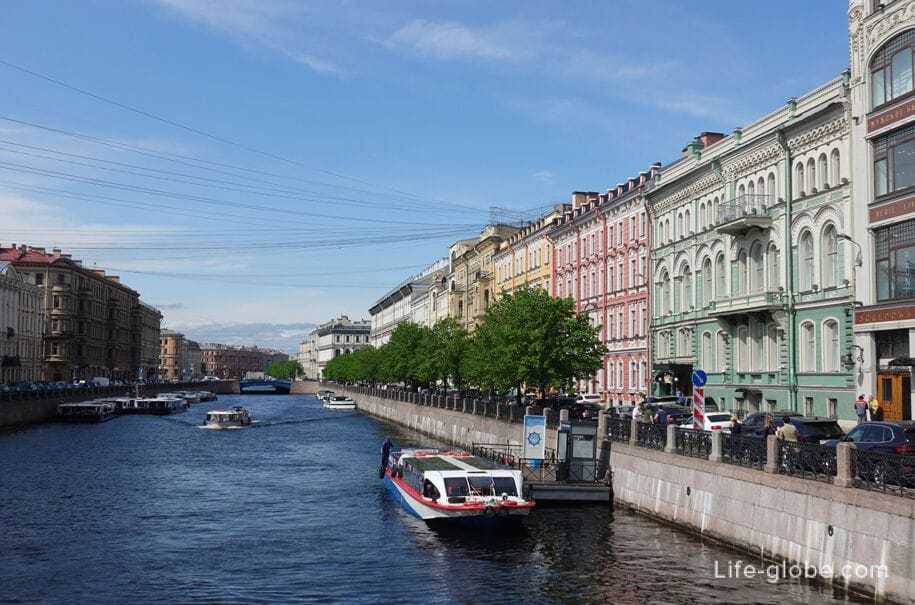
At the address: Moika Embankment 58 there is a former apartment house of A. Zhuen, which has a classicism style and was built in 1913-1914 by architect Roman Fedorovich Meltzer.
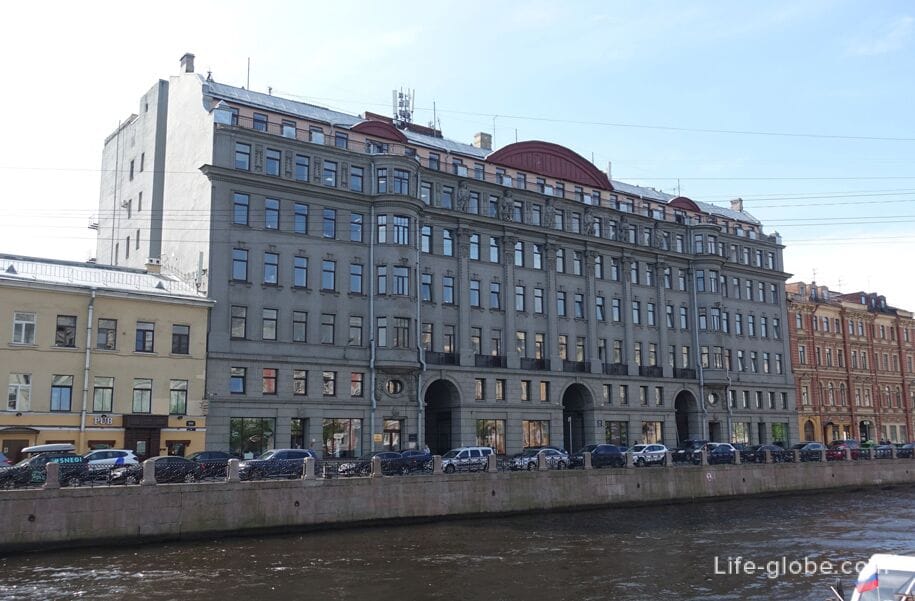
At the address: Moika Embankment 75 there is a small and elegant building in the eclectic style - the Witzin Mansion.
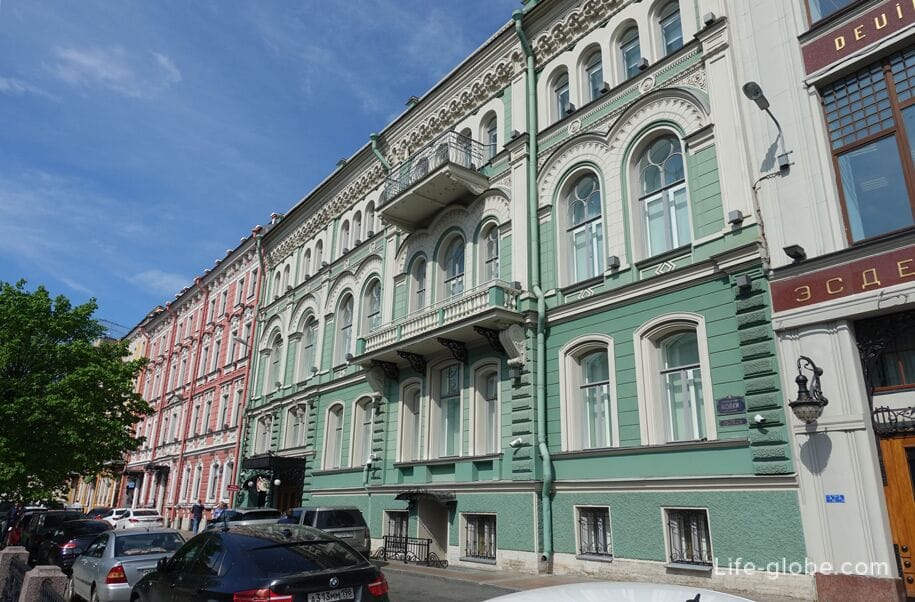
At the address: 77 Moika Embankment, there is a beautiful eclectic building - the apartment house of K.A. Tura.
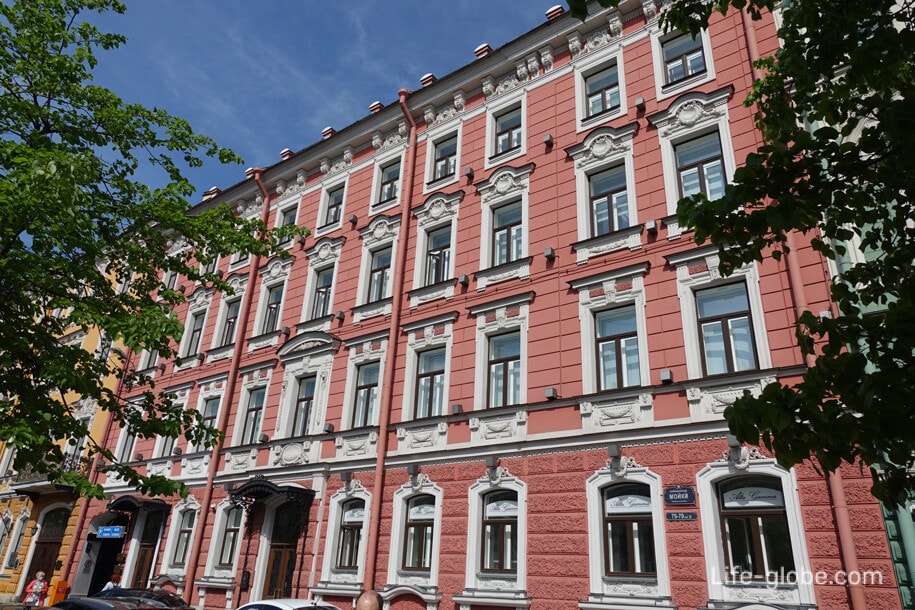
Washing next
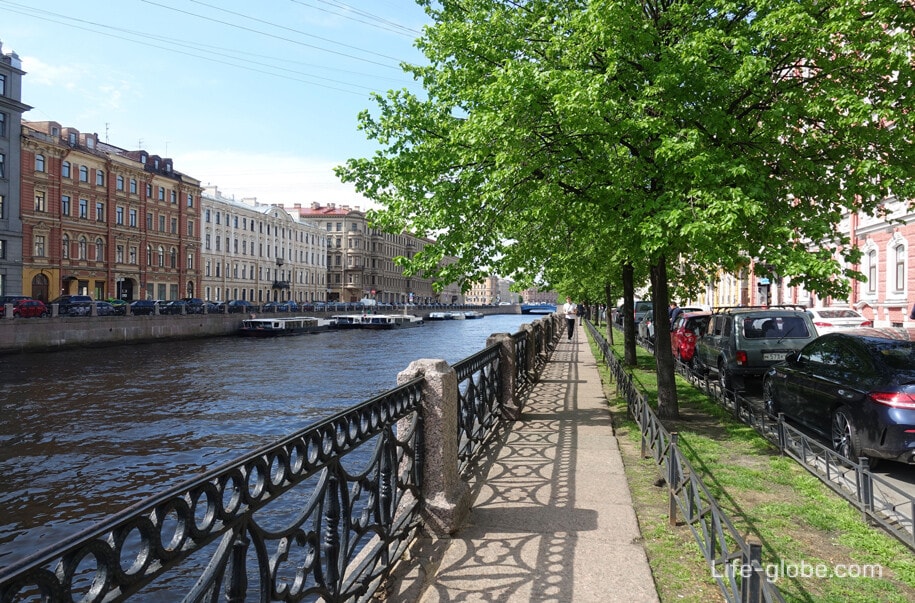
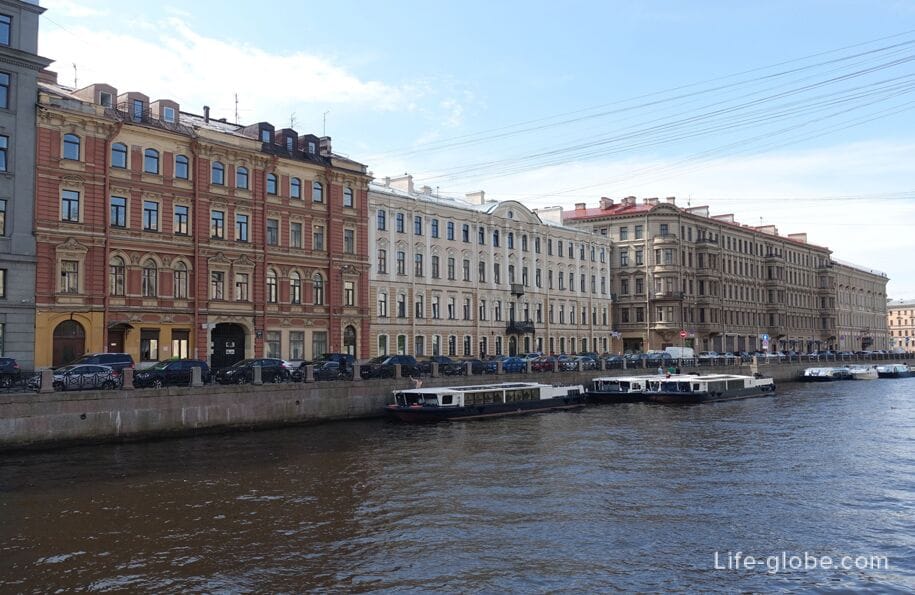
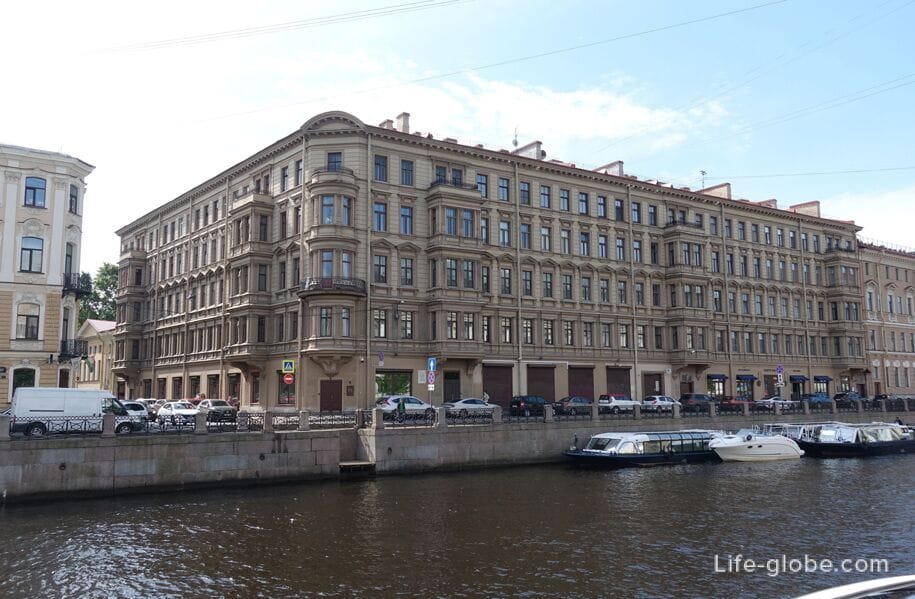
Downstream of the river, the widest bridge in St. Petersburg is thrown across the Moika -The Blue Bridge, which is part of the ensemble of St. Isaac's Square.
With a length of only 29.4 meters, the width of the bridge is 97.3 meters. The width of the bridge on the eaves is 95.4 meters, and the width on the postcards is 113.85 meters.
The blue bridge connects the main part St. Isaac's Square, where there are St. Isaac's Cathedral with an observation deck, St. Isaac's Square, monument to Nicholas I and the 5-star Astoria Rocco Forte Hotel link to the hotel, with The Mariinsky Palace. Learn more about the Blue Bridge...

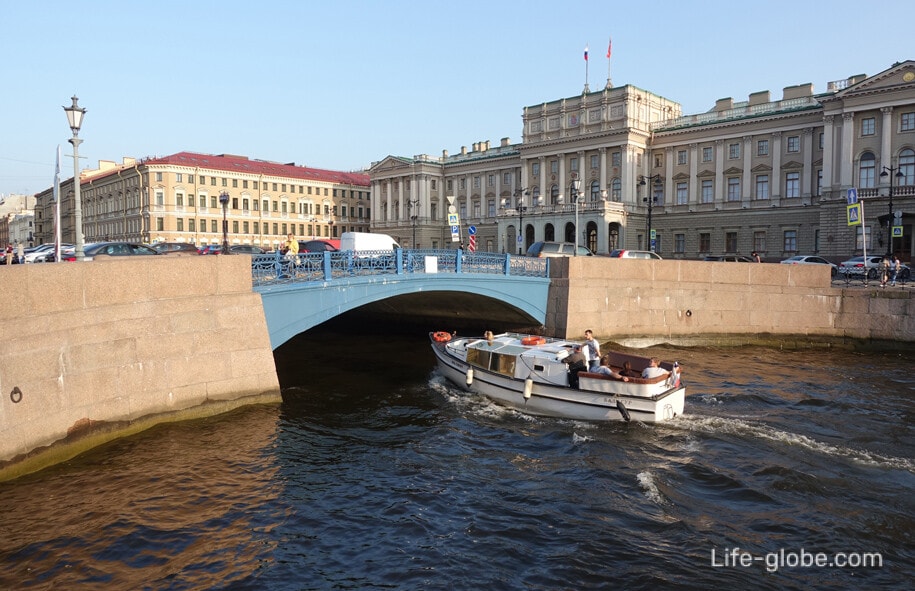
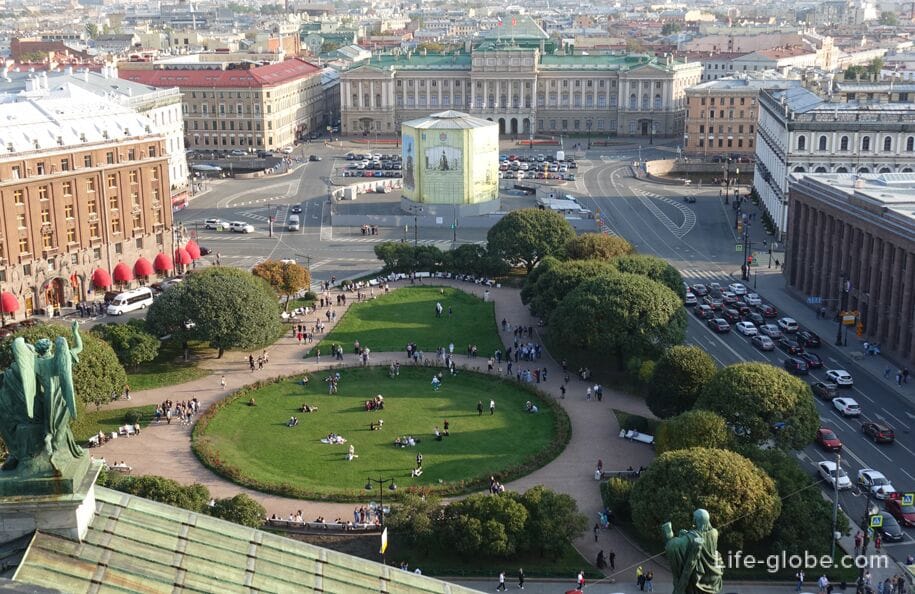
At the Blue Bridge, on the side of St. Isaac's Square, there is a stele with flood marks, also known as the St. Petersburg flood water meter obelisk.
The granite pillar-footstock is made in the form of a tetrahedral obelisk and is topped with a bronze trident of Neptune with the date "1971" (the date of the pillar's erection).
The lower part of the water measuring column goes into the water.
The level of the largest floods in the city is indicated by bronze ribbons encircling the obelisk, with dates stamped on them. The worst was the flood of 1824. Learn more about the water column...
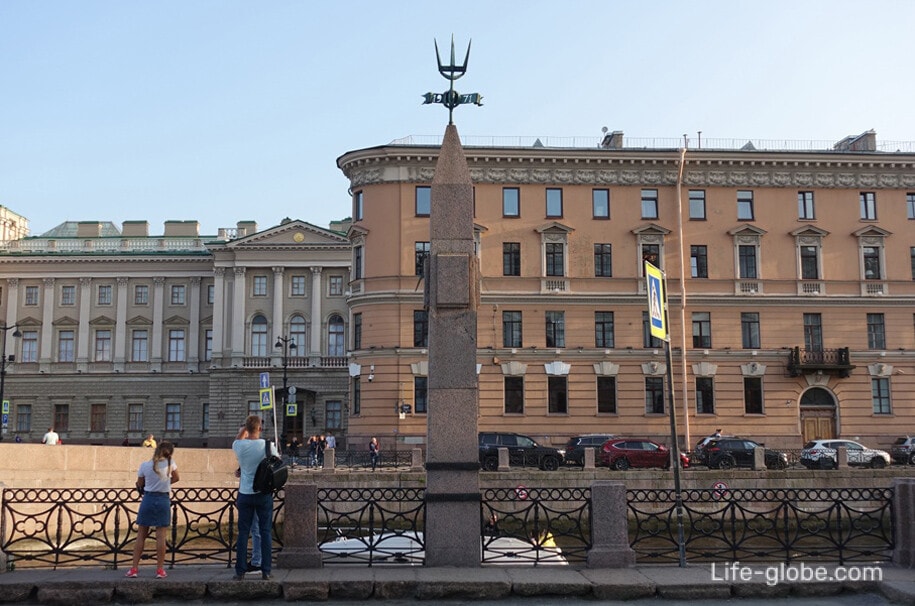
The river and the Moika embankment further


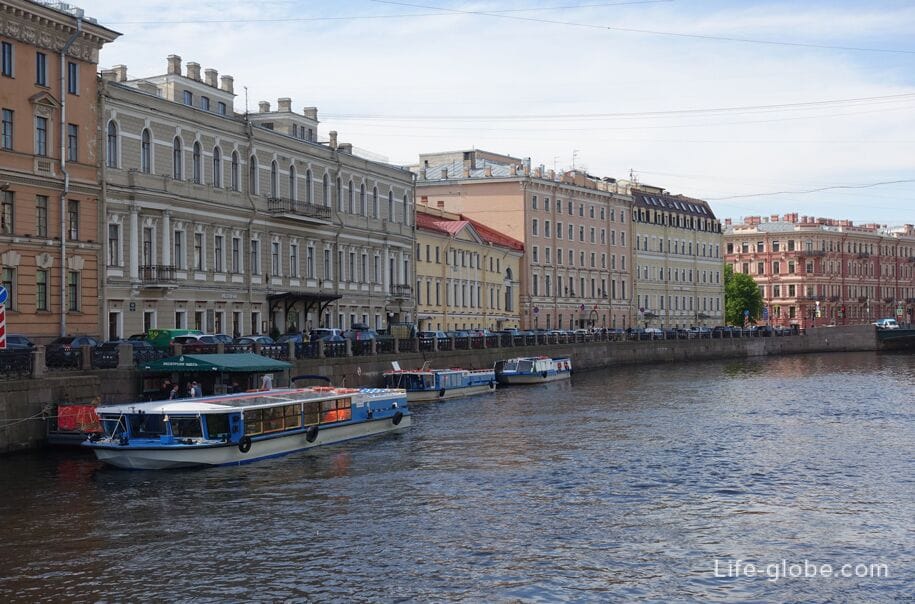

From the ensemble of buildings in this part of the Moika, a small yellow building in the classicism style stands out especially; with pilasters, a small triangular pediment and an arched window, located at 74 Moika River Embankment.
This is the State Controller's house - a residential building (with outbuildings).
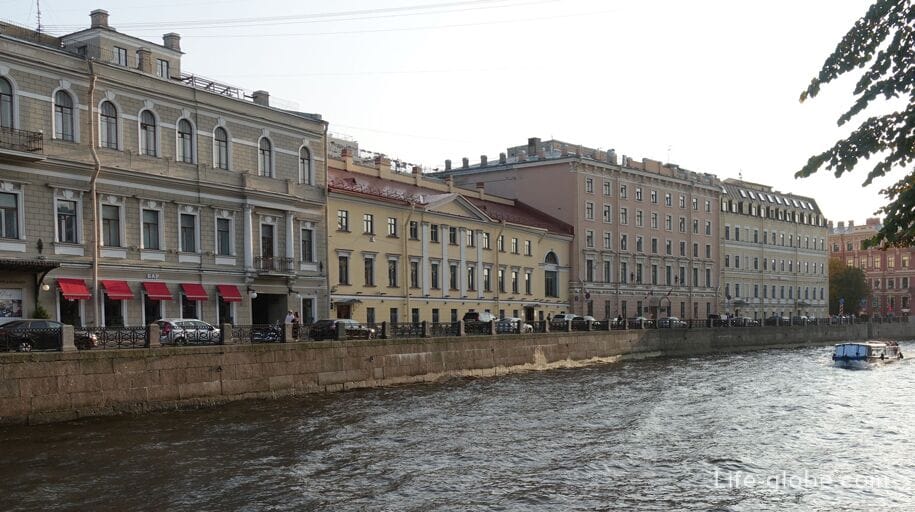
Downstream of the river is locatedA lantern bridge, which is a single-span structure, the superstructure of which is made of precast reinforced concrete and by design is a double-hinged frame.
The railings of the bridge are cast-iron grilles made according to the type of fencing of the Moika River.
At the entrance to the Lantern Bridge, on both sides of it, there are hexagonal lanterns on metal floor lamps. There are four lanterns in total.
The bridge is both carriageway and pedestrian. Learn more about the Fonarny Bridge...
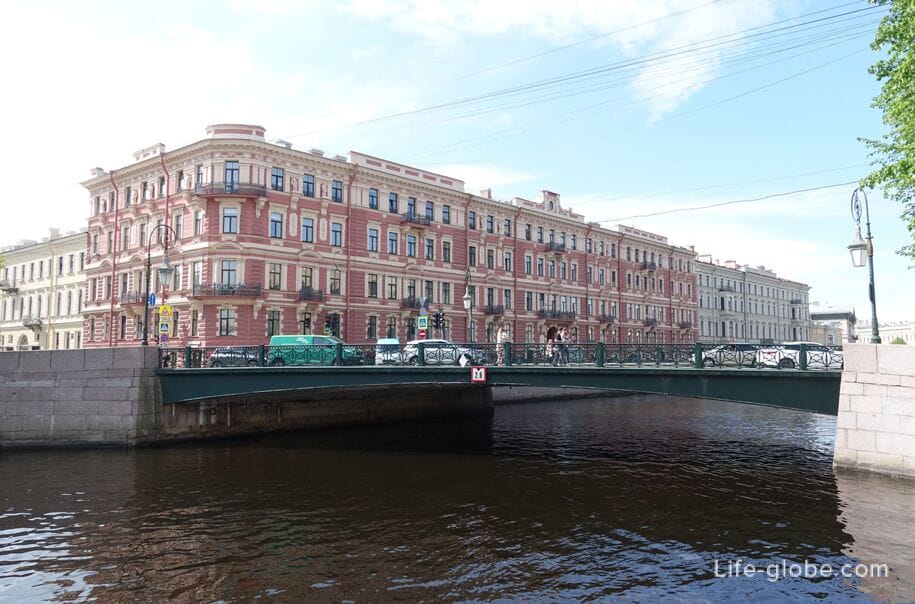
Next to the Lantern Bridge are notable:
- the apartment house and folk baths of M.S. Voronin is a complex built at the end of the 18th century and has an eclectic style. The baths still function today under the name "Lantern Baths".
Address: Moika River embankment, 80-82 / Lantern Lane, 1. Learn more about the apartment building and baths with photos and website...

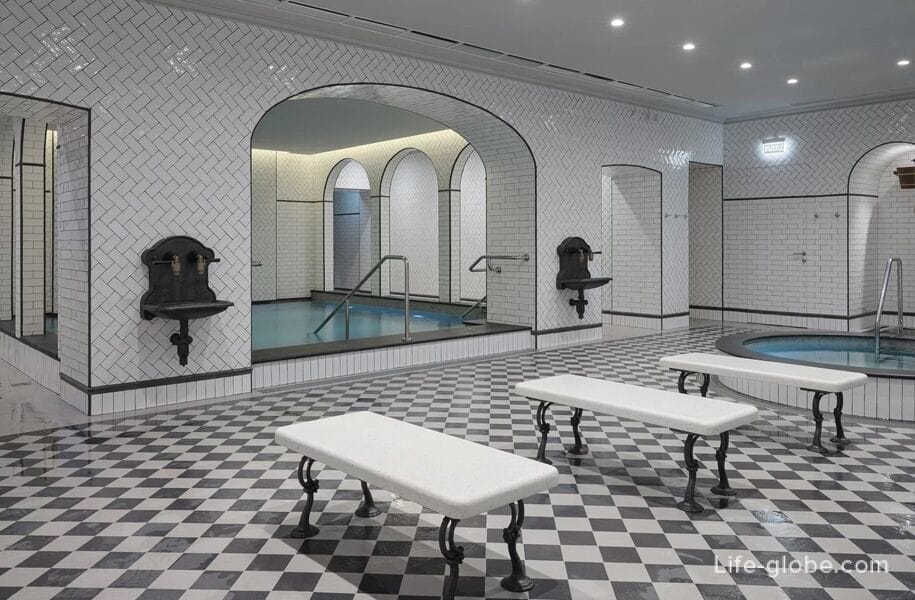
- the former Palace of Culture of Communication Workers, rebuilt in 1932-1939 by architects P.M. Grinberg and G.S. Raitz from the former German Reformed Church.
It was a pseudo-Romanesque temple with a high two-tiered bell tower, and the windows were decorated with stained glass. The walls of the facades of the building were made of red brick without plaster, individual elements were painted white. In 1929, the church was closed and rebuilt by 1940.
The building is designed in the style of constructivism.
Building address: Moika River embankment, 101x / Bolshaya Morskaya Street, 58 / Pochtamtsky Lane, 9.
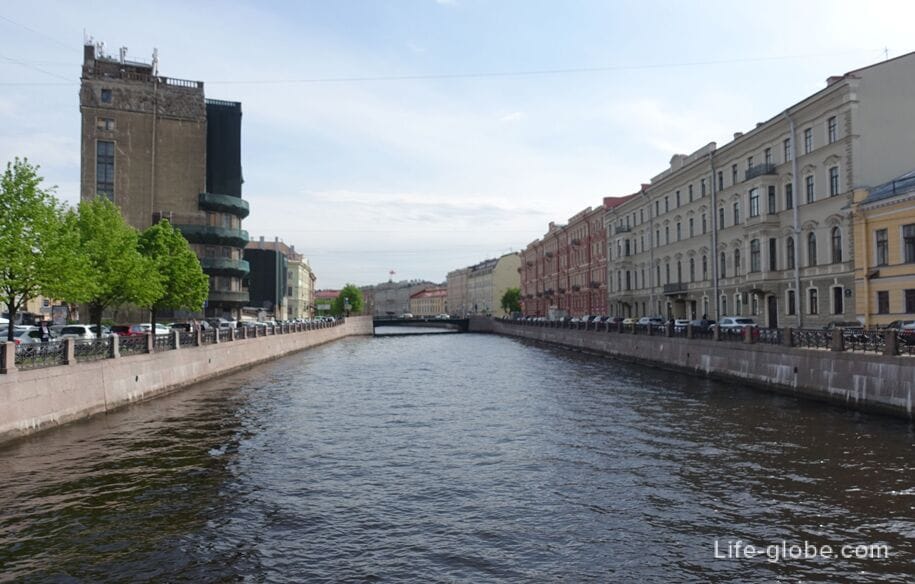
Downstream of the Moika River there is a pedestrian Pochtamtsky Bridge.
This bridge has survived to the present day in its historical design and is unique in its kind, since it is the only pedestrian chain suspension bridge in the city.
In 1822-1827, seven chain suspension bridges were built in St. Petersburg, of which only three have survived to this day: Bank and Levin across the Griboyedov Canal, as well as the Post Office Bridge over the Moika. At the same time, the Bank and Lion Bridges are actually girder bridges, where the chains perform only a decorative function, while the Post Office Bridge has preserved (was restored) the original "hanging" structure created in the first quarter of the 19th century. Learn more about the Pochtamtsky Bridge...

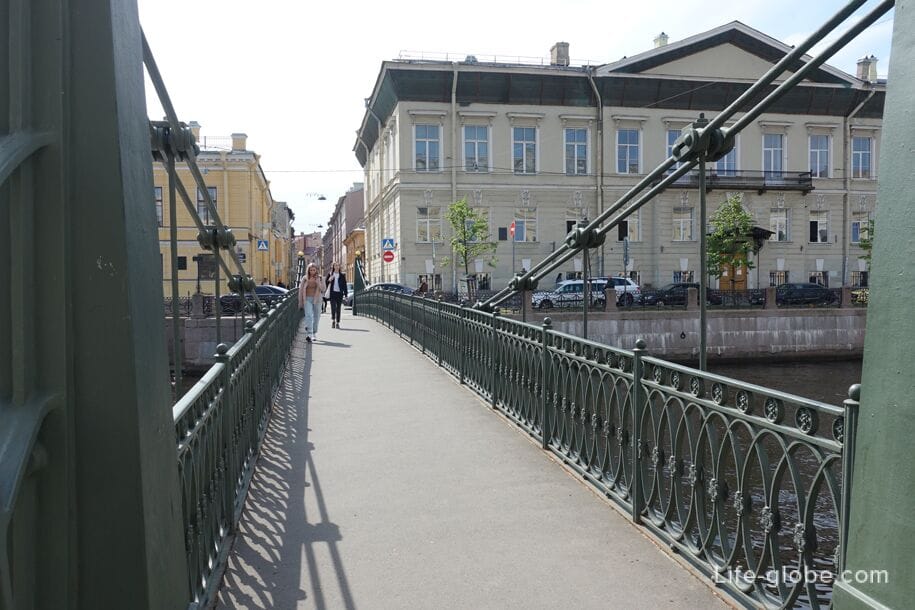
Near the Post Office Bridge, on the even side of the Moika River embankment, two buildings are notable:
- number 86-88 is the Montferrand mansion, decorated in the Italian Renaissance style and distinguished by a powerful bay window above the main entrance.
The building was built in 1743-1744 according to an exemplary design, and then rebuilt. During the history, the building housed: the Italian Embassy, the design institute "Giproruda", the prosecutor's office.
Fr . Montferrand , the architect of St. Isaac 's Cathedral , lived in house No. 86;

- number 90 is the house of A.M. Golitsin, which has the style of classicism.
The building was built from the end of the 18th century until 1816, and was expanded in the 20th century.

In the place where the Moika embankment merges with Bolshaya Morskaya Street (No. 59), the mansion of G.P. Mitusov, also known as the mansion of E.F. Junkers, attracts attention.
The building is made in the neo-Renaissance style.

And at the address: 61 Bolshaya Morskaya Street, there is a long building - a post office and a brick, which has a neo-Renaissance style and was built in 1843-1845.
The building is also known as the Lomonosov manor house, because this place is the manor house where the great Russian scientist Mikhail Vasilyevich Lomonosov lived and worked from 1757 to 1765.
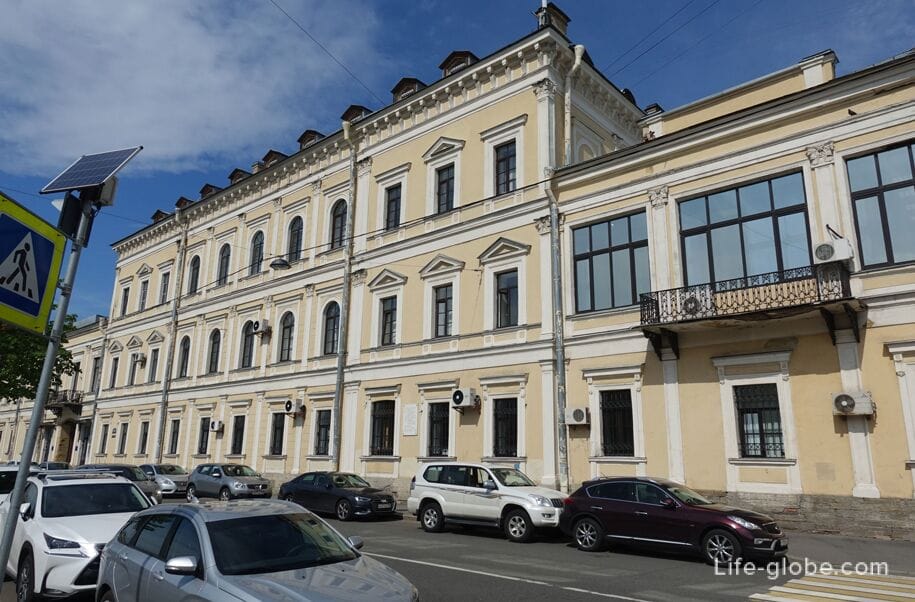
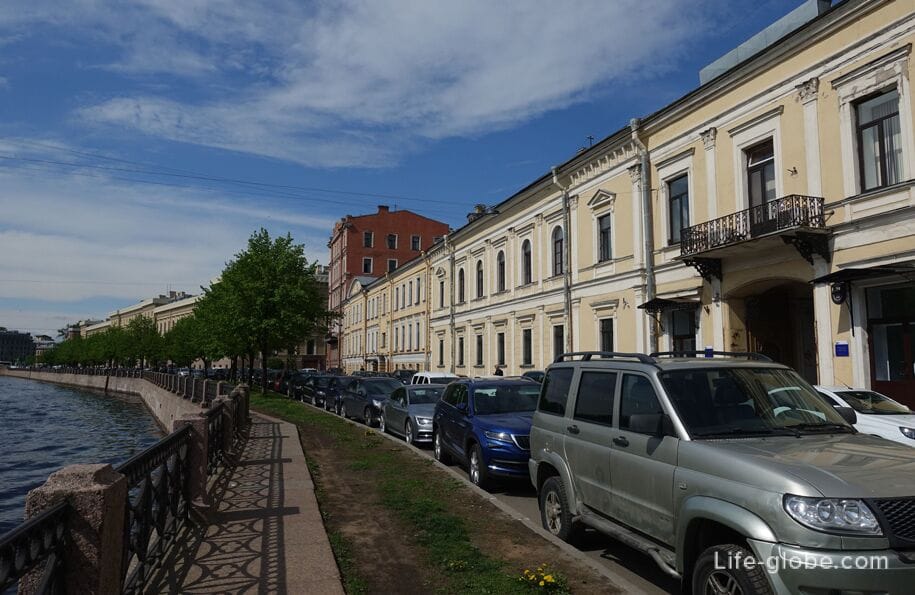
The river and the Moika embankment further
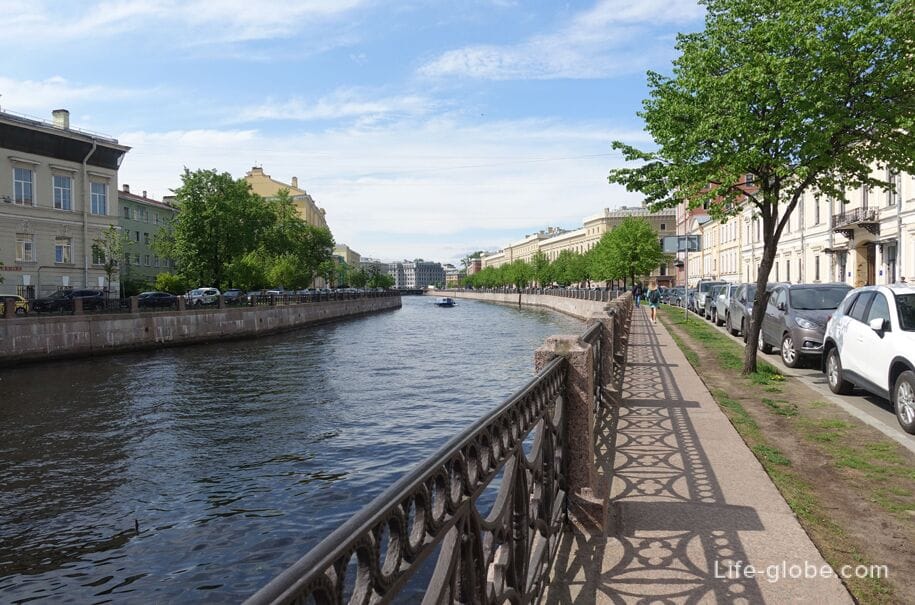
At the address: Moika River Embankment 94, there is, perhaps, the main decoration of the river and one of the brightest and most visited sights of St. Petersburg - the Yusupov Palace on the Moika.
This is a former noble manor, as well as a monument of history and culture, which is an architectural ensemble of the 18th and 20th centuries, consisting of a palace with a front yard, former wings, a garden pavilion, an inner courtyard and a garden.
Today the Yusupov Palace is a museum. The halls and rooms of the palace can be visited with various sightseeing routes for a fee. Also in the premises of the former estate there is an exposition "The Murder of G. Rasputin", exhibitions, concerts, performances, etc. are held.
You can take a walk in the palace garden for free.
Entrance to the palace and garden for individual visitors from Decembristov Street, 21. More about the Yusupov Palace...
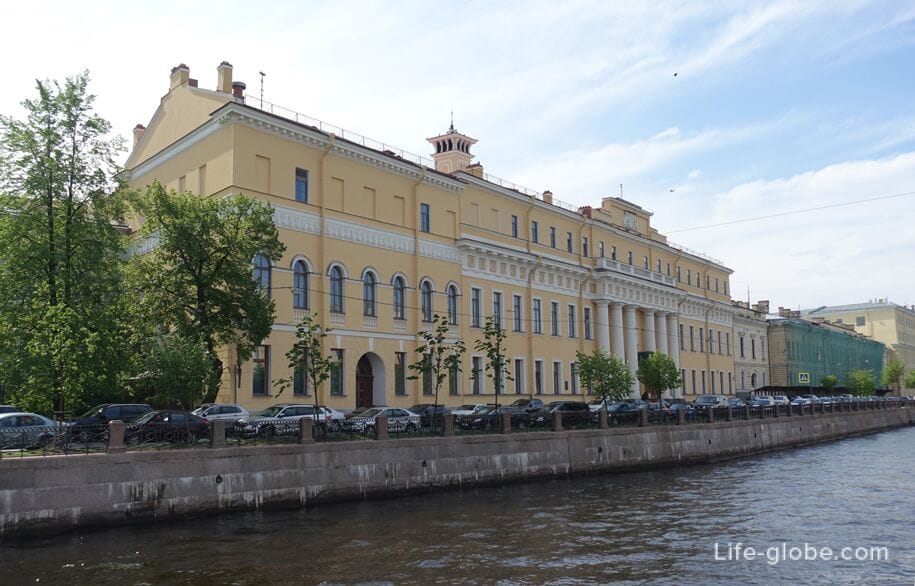
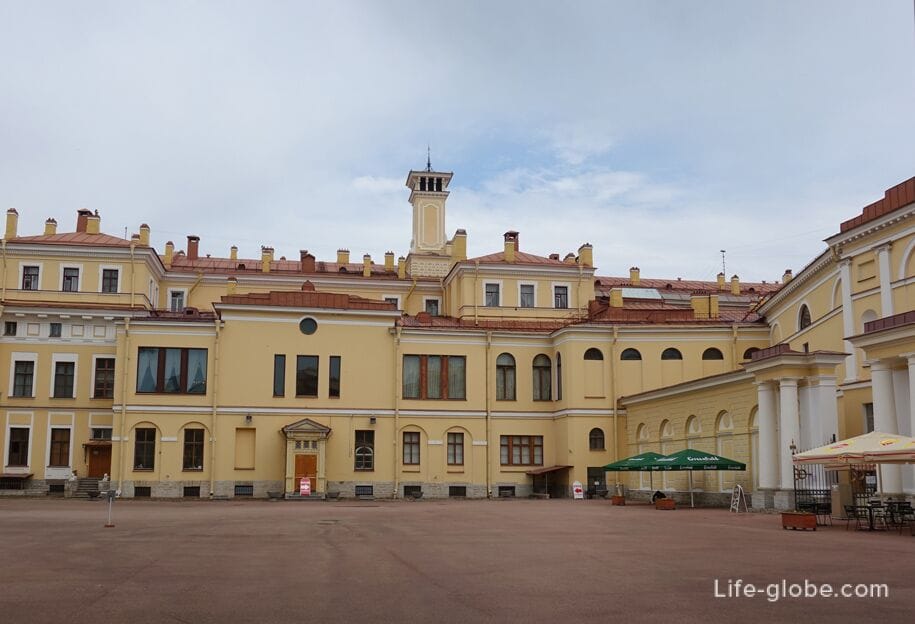
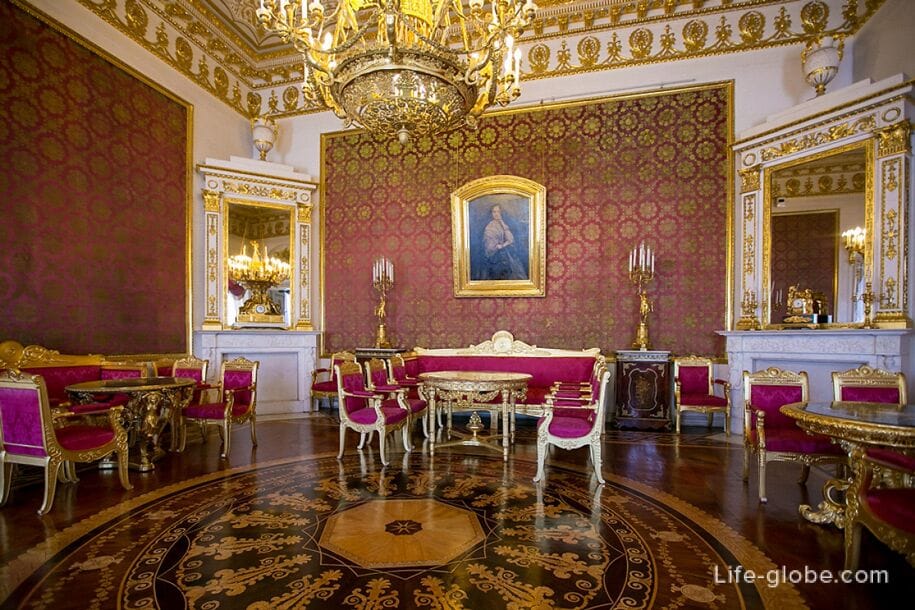
There is a bridge with a romantic name downstream of the Moika River - Kissing bridge.
This is one of the most iconic bridges in St. Petersburg, which has gained popularity and is overgrown with legends thanks to its name. The bridge is sometimes called the Bridge of Kisses.
The Kissing bridge is a single-span arch, the span of which is made in the form of a steel double-hinged arch. There are four granite obelisks on the abutments of the bridge.
The bridge is both carriageway and pedestrian.
Several legends are connected with the bridge. Learn more about the Kissing Bridge, its name and legends...
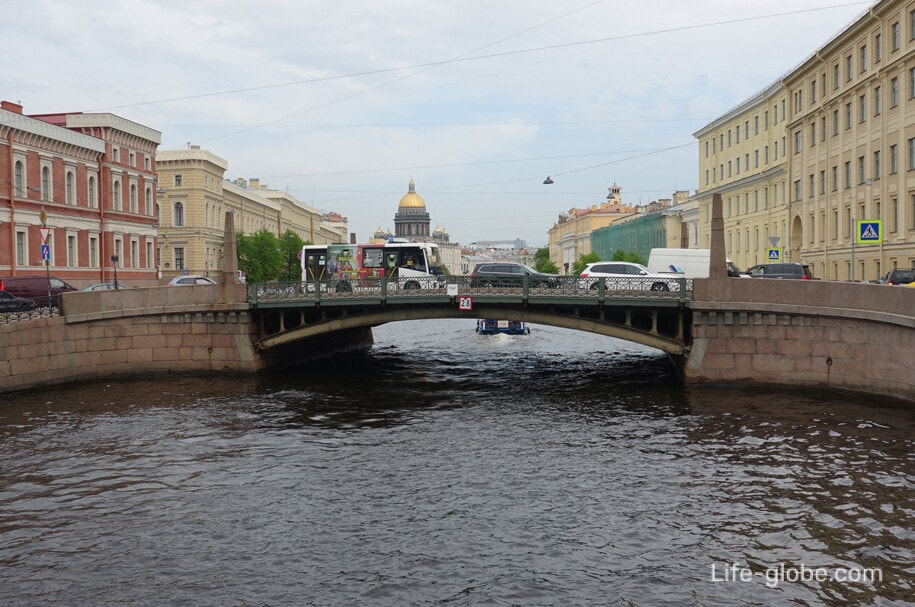
Next to the Bridge of Kisses is the Central Naval Museum named after Emperor Peter the Great, located in the building of the former Kryukov Barracks and is one of the oldest museums in Russia and one of the largest maritime museums in the world, with one of the richest collections of ship models.
The pride of the museum is the original boat of Peter I, originally stored in Bot House Peter and Paul Fortress.
Museum website: navalmuseum.
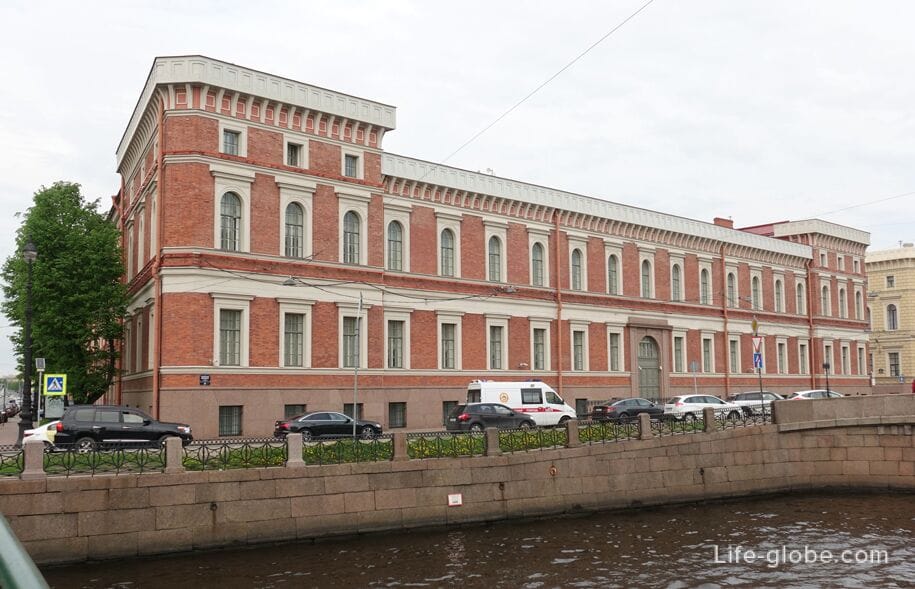
Near the Potseluev Bridge , a pedestrian bridge is thrown over the Moika Krasnoflotsky Bridge.
The bridge is a single-span structure of a beam-split system.
Artistic metal floor lamps with lanterns, stylized as Art Nouveau, are installed at the entrances of the bridge. Learn more about the Krasnoflotsky Bridge...
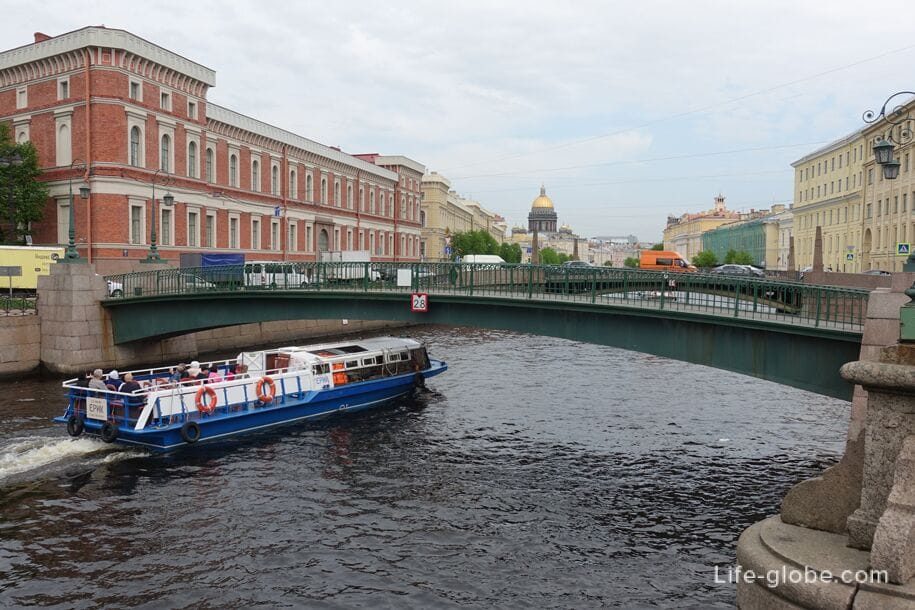
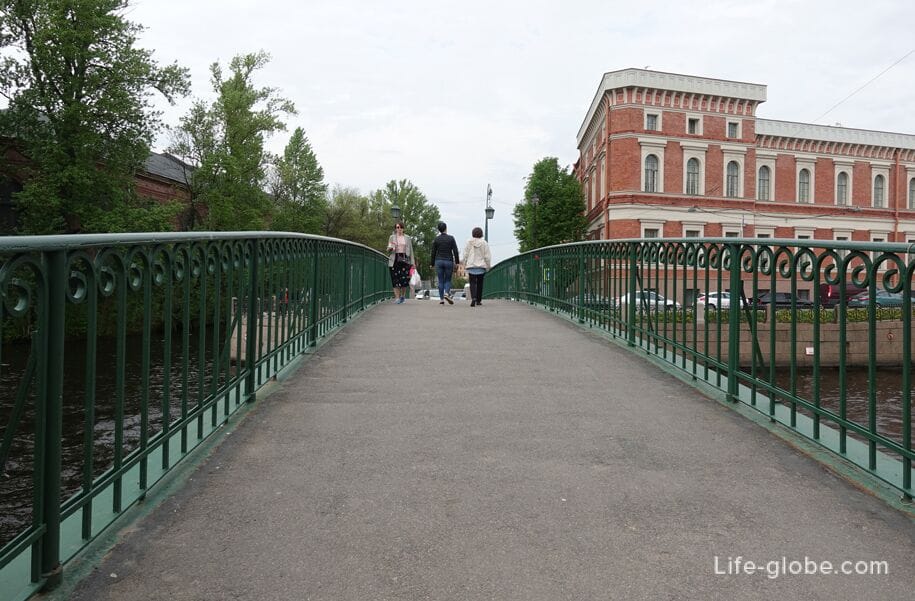
In the alignment of the Moika River, through Kryukov Channel is thrown over Matveev Bridge, which has preserved the general architectural appearance characteristic of the Kryukov Canal bridges of the 1780s.
The bridge is a three-span structure.
On the intermediate river supports of the bridge, on granite pedestals, four shaped floor lamps of artistic casting with round lanterns are installed.
The bridge is both carriageway and pedestrian. Learn more about the Matveev Bridge...
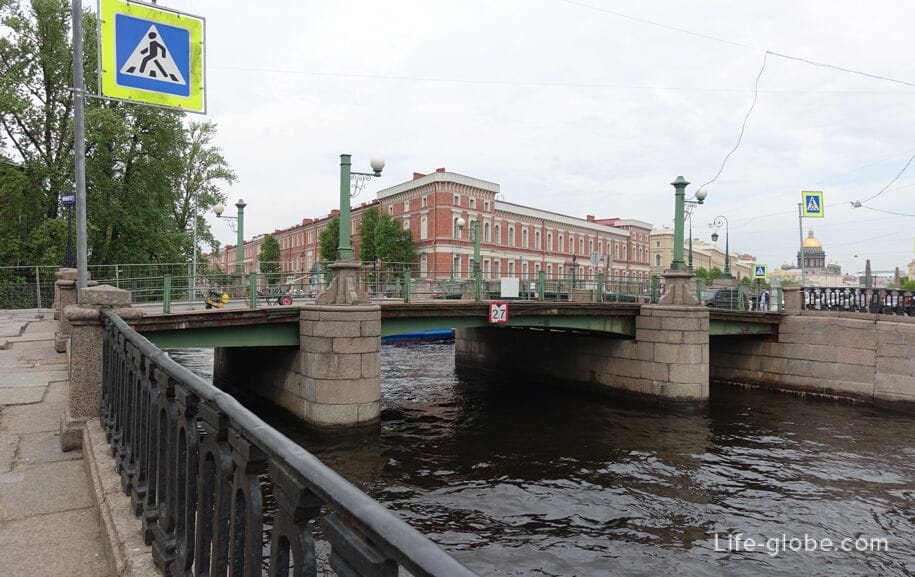
Matveeva near the bridge (both sides), at the intersection of the Moika river and the Kryukov Canal bridge, located corner of the building, one of which is residential clubhouse, and the second (the Moika river Embankment, 100) is a Museum and exhibition center of the St. Petersburg Union of artists and art Museum (website: piter-art).

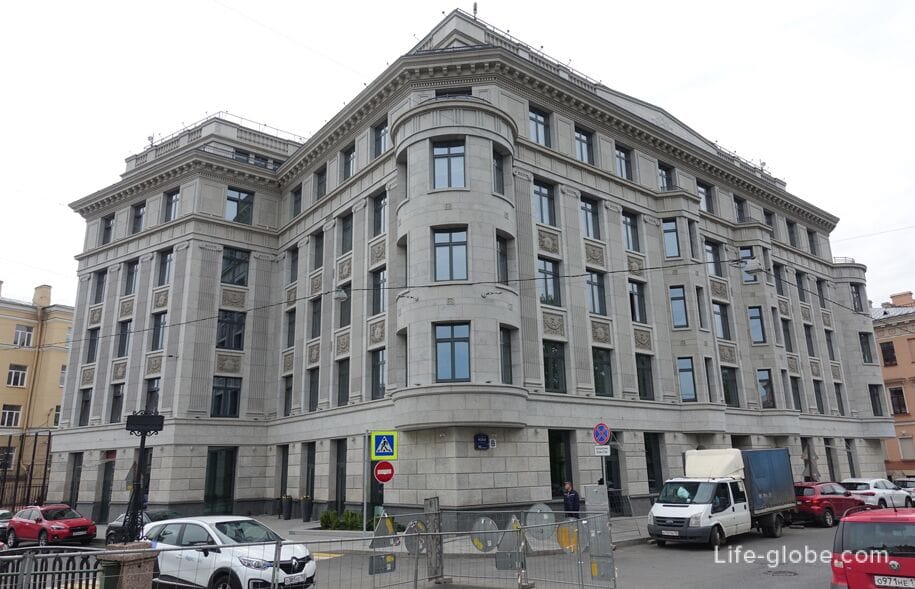
Further on the north side of the Moika stretches the island of New Holland, which is man-made and is bounded by the Moika River and canals.
Today, New Holland is a well-maintained recreation area with a park, a pond, playgrounds, catering places and retail outlets. The island is also a platform for creativity, where something is constantly happening.
In addition, New Holland is a unique monument of industrial architecture of early classicism in St. Petersburg. More about the island of New Holland...
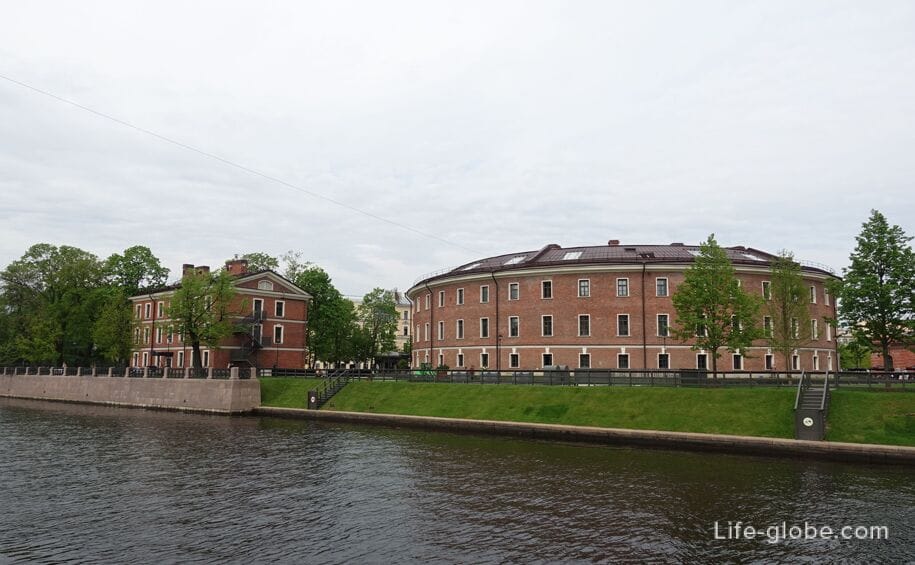
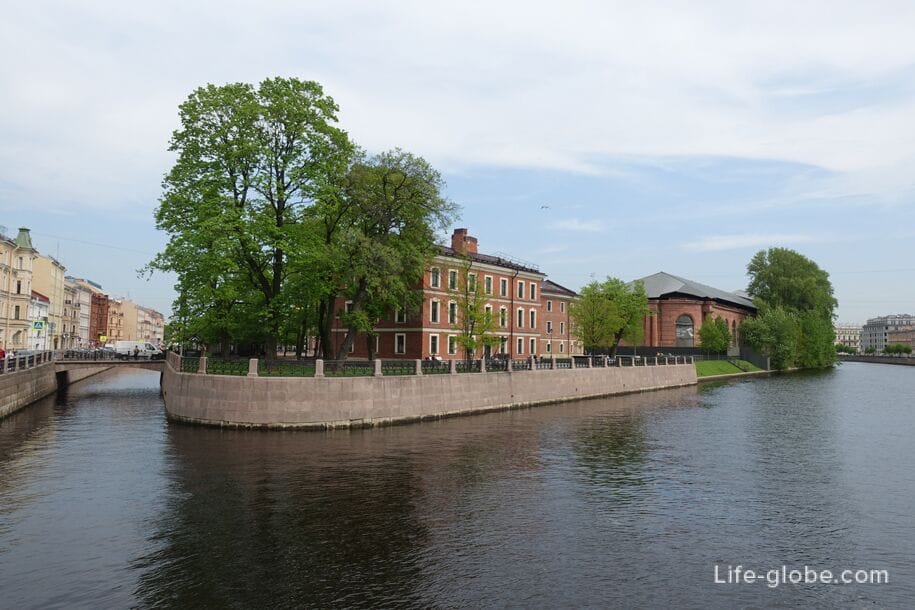
Wallen Delamot Arch on the island of New Holland
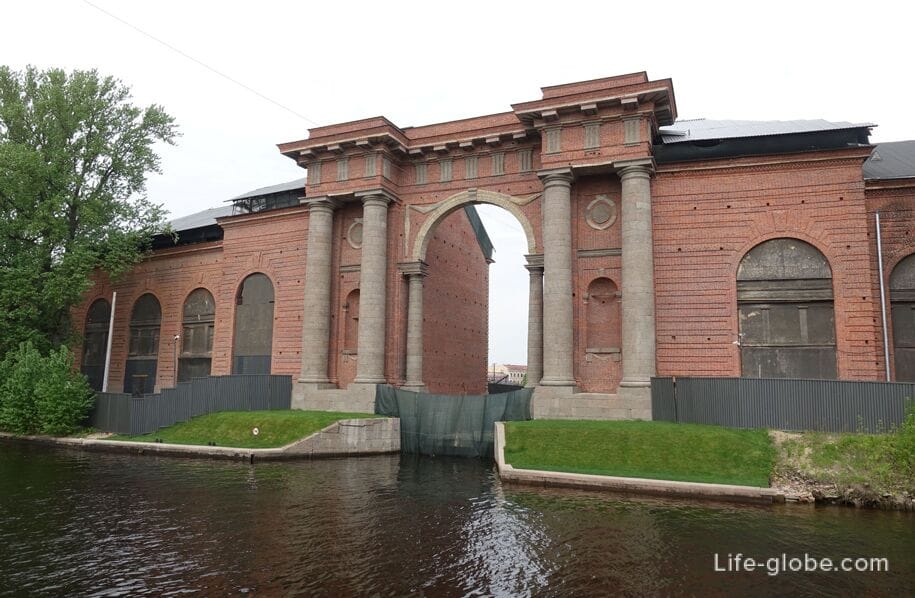
Washing next
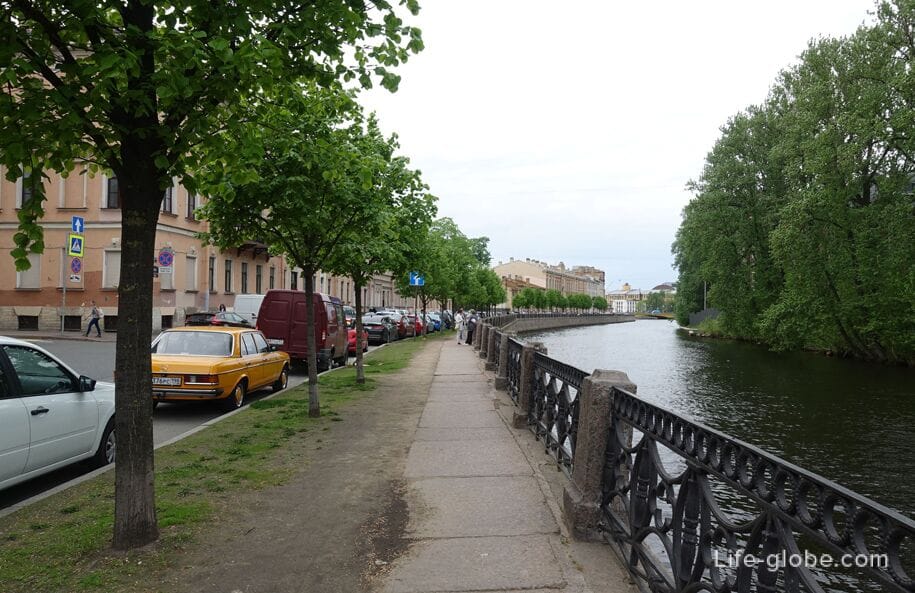
At 106 Moika River Embankment is the palace of Grand Duke Alexander Mikhailovich (grandson of Emperor Nicholas I), which now houses the P.F. Lesgaft National State University of Physical Culture, Sports and Health.
For Grand Duke Alexander Mikhailovich, the building (the former palace of Princess MV Vorontsova) in 1895-1897 was partially rebuilt by civil engineer Nikolai Ivanovich de Rochefort (Rochefort).
The complex is designed in an eclectic style.
The garden facade of the palace is treated with rusticated blades and cut through with high windows. The building is completed by a high mezzanine with a balustrade.


Moika Embankment next
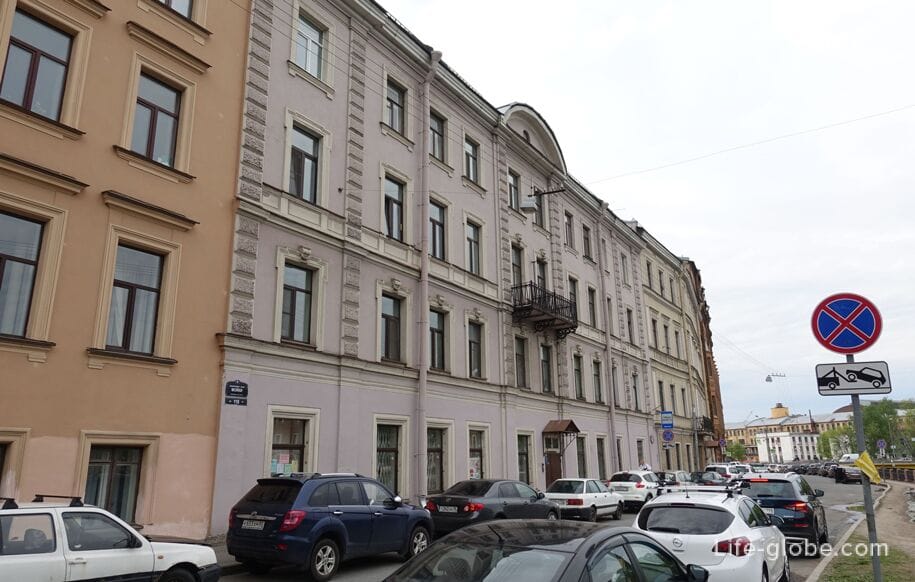
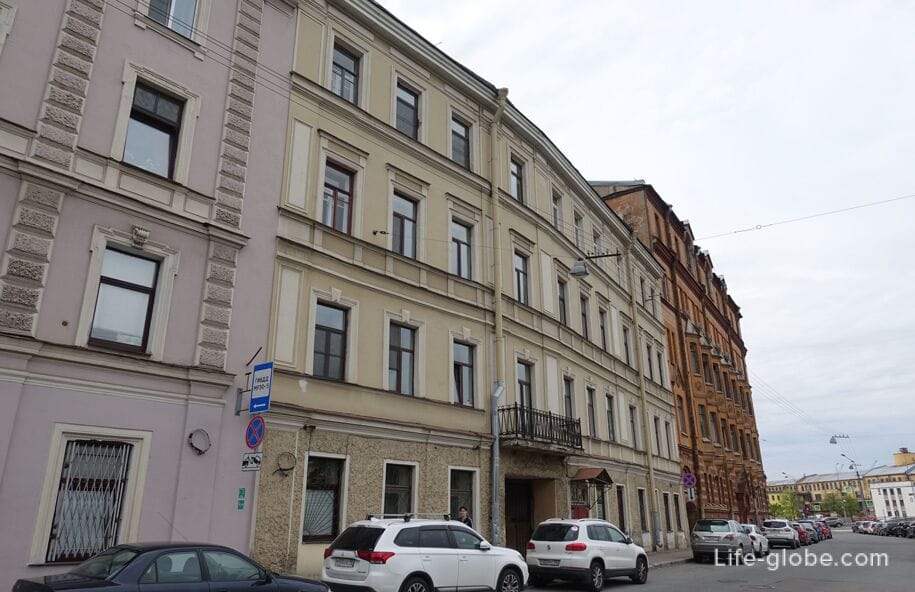

On the Embankment of the Moika River 112 and 114 there are two buildings - a mansion and V.A. Schroeter's own house, made in brick style with Gothic elements and once belonged to one person - Viktor Alexandrovich Schroeter. More about Schroeter's houses on the Moika...
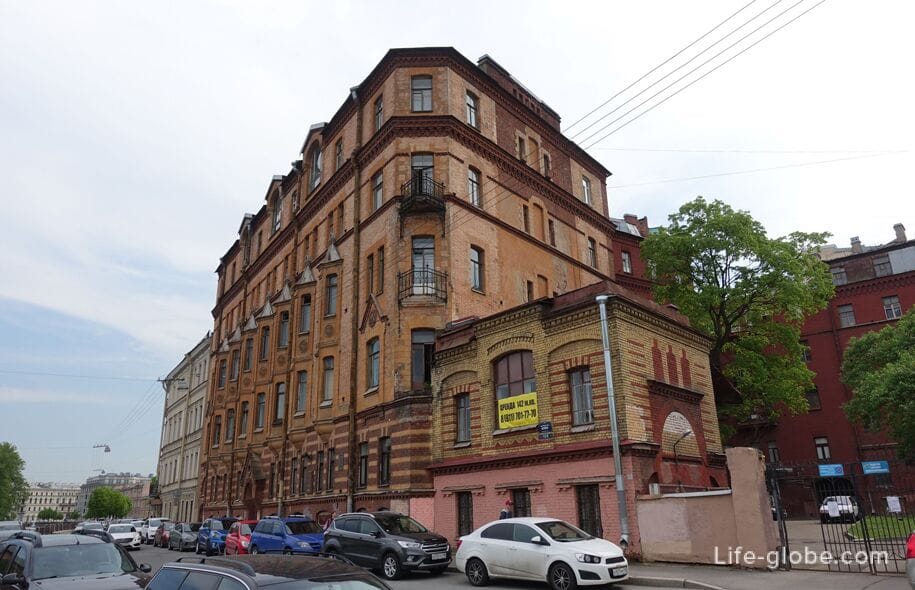
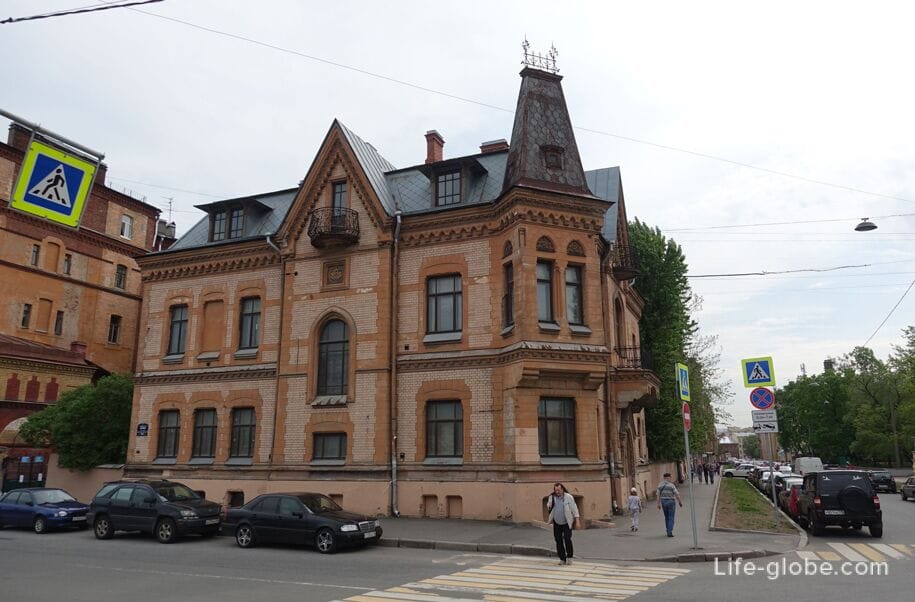
Below , the Moika is thrown across the riverThe Khrapovitsky Bridge, which is a single-span reinforced concrete structure of a frame-cantilever system, the superstructure of which is made of prestressed reinforced concrete and has a curved outline of the lower belt.
A cast-iron lattice of a modern pattern is installed on the bridge. Granite curbstones are located at the ends of the railing. Learn more about the Khrapovitsky Bridge...

At the northern side of the Khrapovitsky Bridge, where the Admiralty and Novo-Admiralty Canals flow, there is a former Bobrinsky Palace, which is made in the style of classicism and now houses the Faculty of Liberal Arts and Sciences of St. Petersburg State University.
It was at this place, before the construction of the palace, that the estate of A.V. Khrapovitsky was located, after whom the Khrapovitsky Bridge got its name.
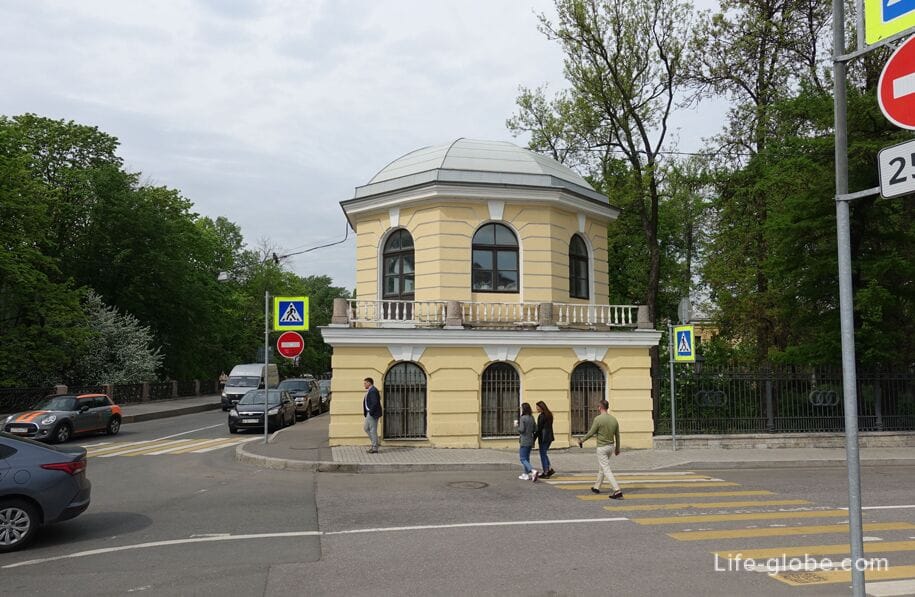
Then the Moika embankment runs near the Admiralty Shipyard, beyond which it flows into the Bolshaya Neva River.

At the address: the embankment of the Moika River 122 is the mansion of A. I. Saburov / the palace of Grand Duke Alexei Alexandrovich, built by architect Maximilian Egorovich Mesmacher in 1882-1885.
Today the building belongs to the House of Music of St. Petersburg and concerts are held in its English Hall, made in the neo-Renaissance style.
Also, the former palace is regularly visited by the "Ceremonial Halls of the Alekseevsky Palace".
House of Music website: spdm.

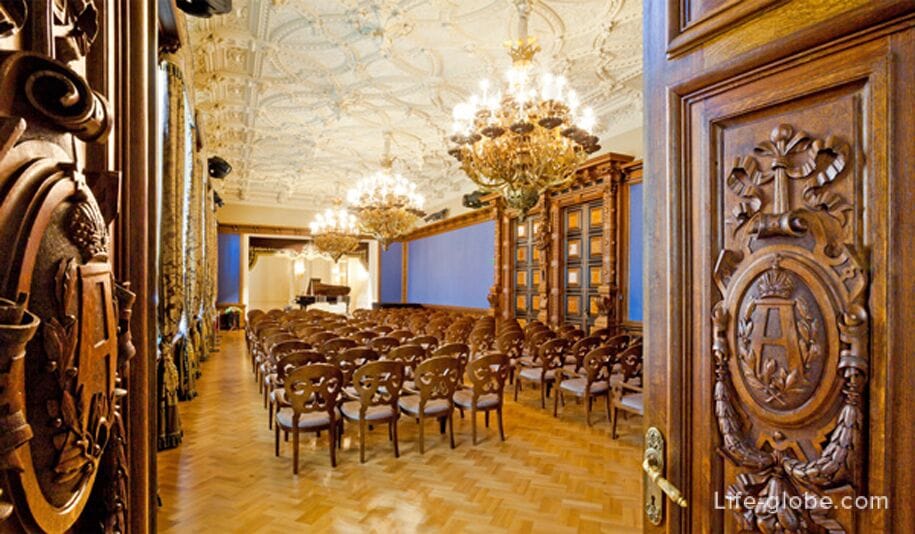
Next isThe Matisse Bridge, which spans the Buckle River at the place where it flows out of the Sink. The bridge connects Matisse and Kolomenskoye Islands.
The length of the bridge is 39.7 meters, and its width is 10.5 meters.
This is a three-span metal structure, the superstructure of which is a double-hinged arch. The abutments of the bridge are on bored piles, lined with granite, the intermediate supports are reinforced concrete, on a pile foundation, lined with granite.
The railings of the bridge are cast iron on metal bollards, the lattice pattern repeats the fence of the Moika River. The pavement on the roadway is asphalt concrete, on the sidewalks - sandy asphalt. The roadway is separated from the sidewalk by a granite curb.
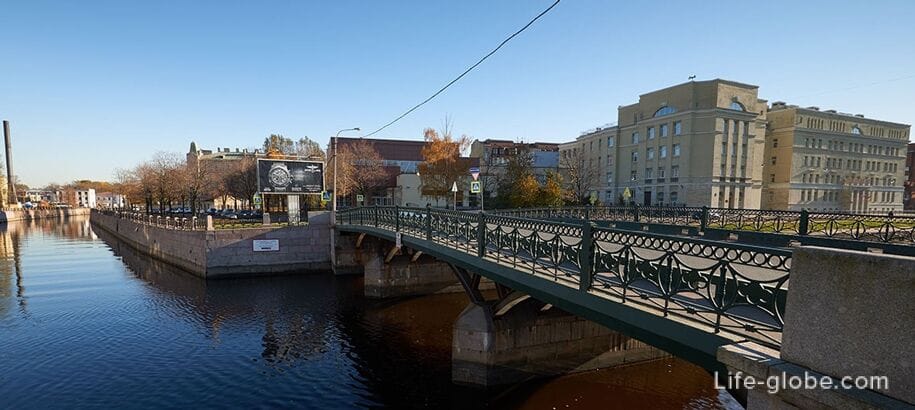
Closes the SinkThe ship Bridge, which is a girder bridge over the Moika River and connects Novo-Admiralteisky and Matisse Islands.
The bridge is located on the territory of the Admiralty Shipyards plant and was named "Ship" in 1977, after the Ship Embankment that existed in this place.
The bridge was built in 1967. It is a single-span steel-reinforced concrete girder bridge. The length of the bridge is 29 meters, and its width is 9.3 meters.
The bridge is designed for the movement of vehicles and pedestrians.
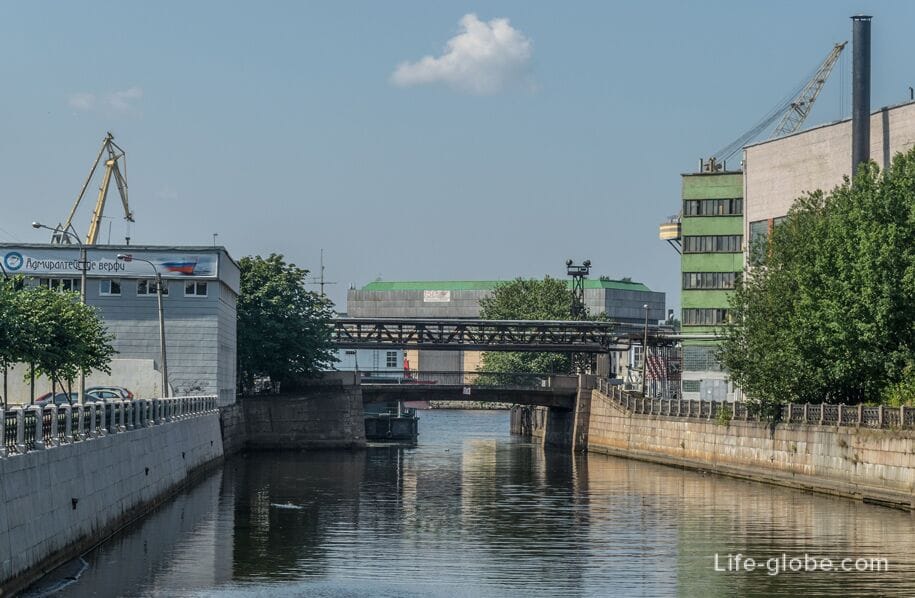
Practical information
Coordinates of the Moika River:
- source of the Sink (Fontanka River): 59°56'30.0"N 30°20'16.0"E (59.941667, 30.337778);
- Moika estuary (Neva River): 59°55'35.0"N 30°16'25.0"E (59.926389, 30.273611).
Nearest metro stations: "Chernyshevskaya", "Admiralteyskaya", "Nevsky Prospekt", "Gostiny Dvor", "Sadovaya", "Spasskaya" and "Sennaya Ploshchad".
All accommodation facilities in St. Petersburg, including in the city center, on and near the Moika River Embankment, as well as more remotely, can be viewed and booked here




